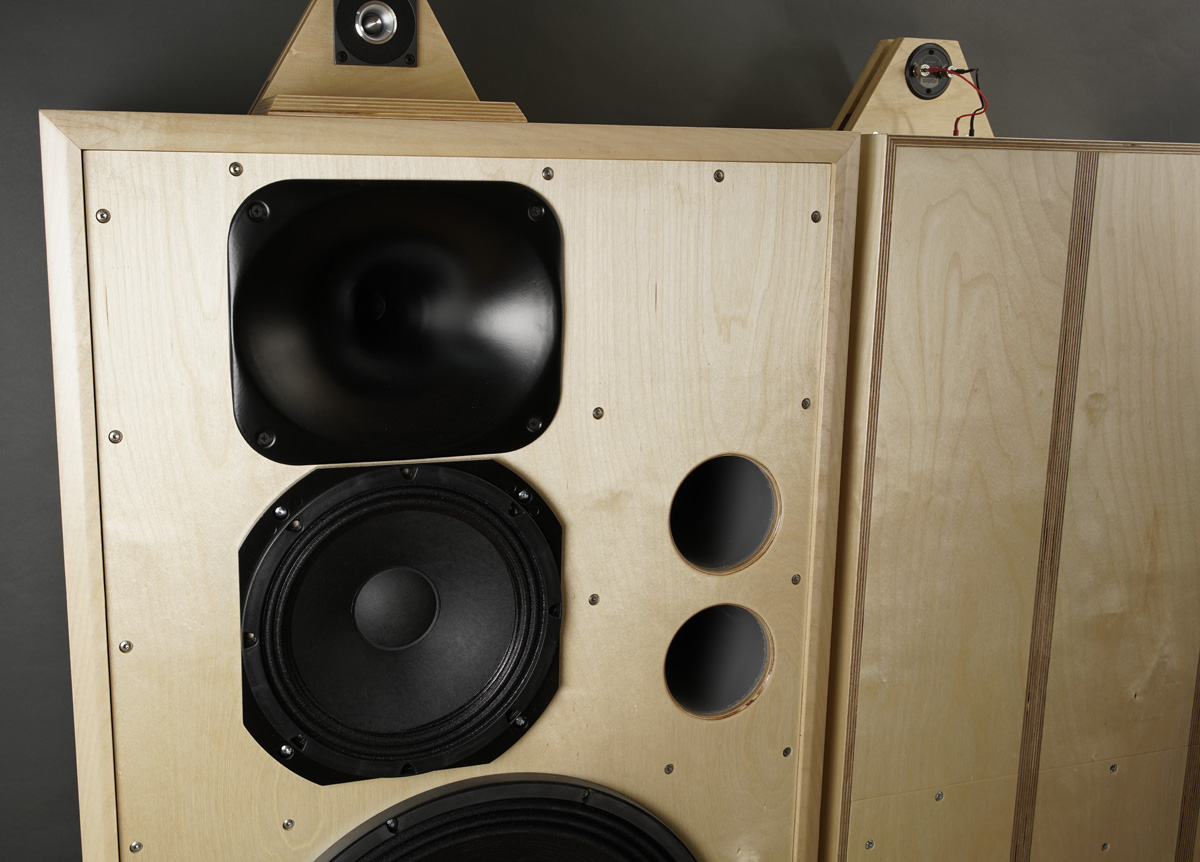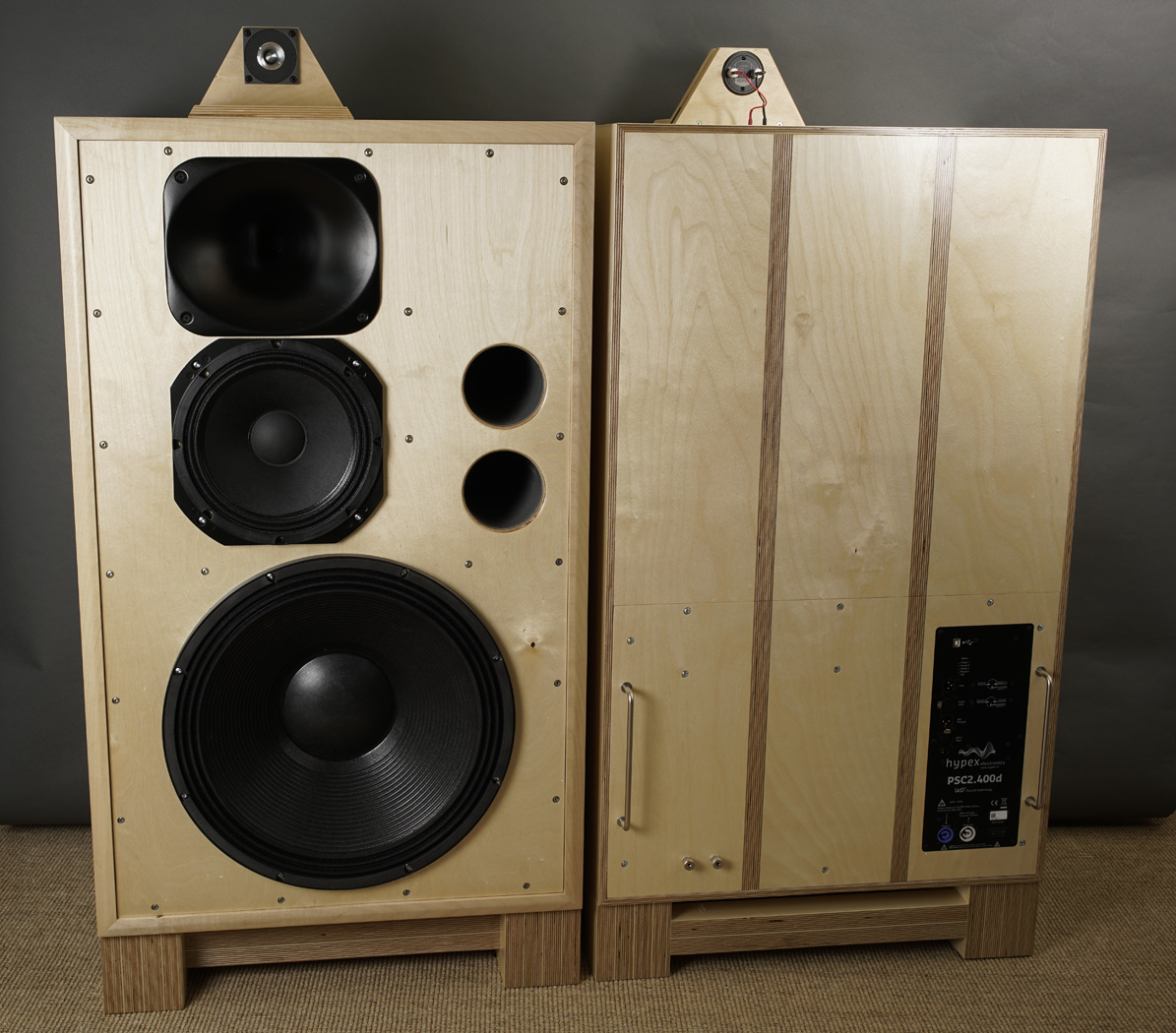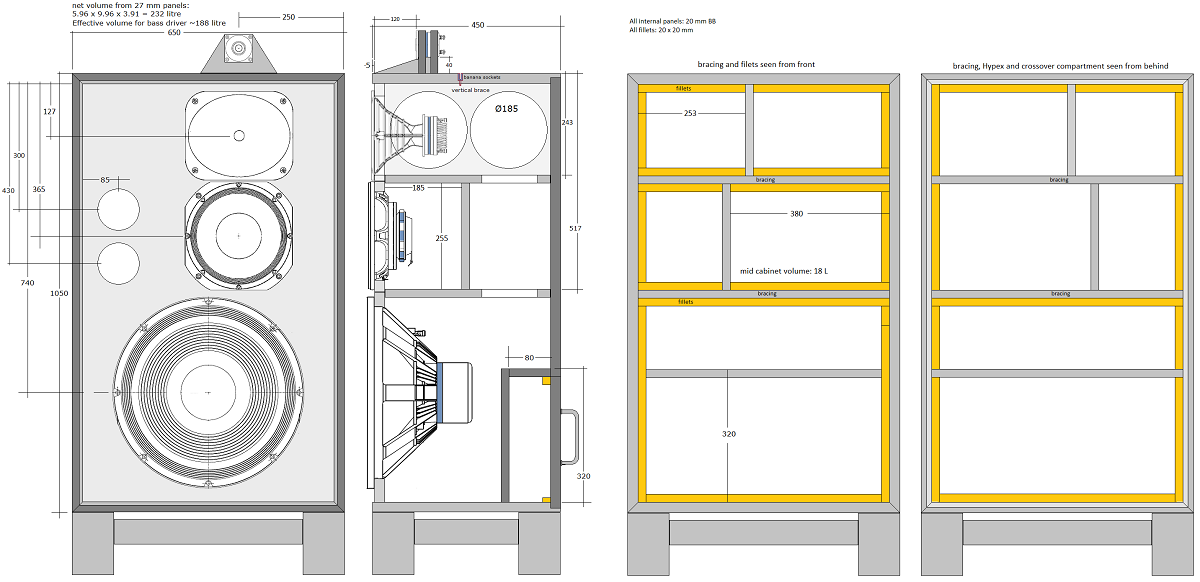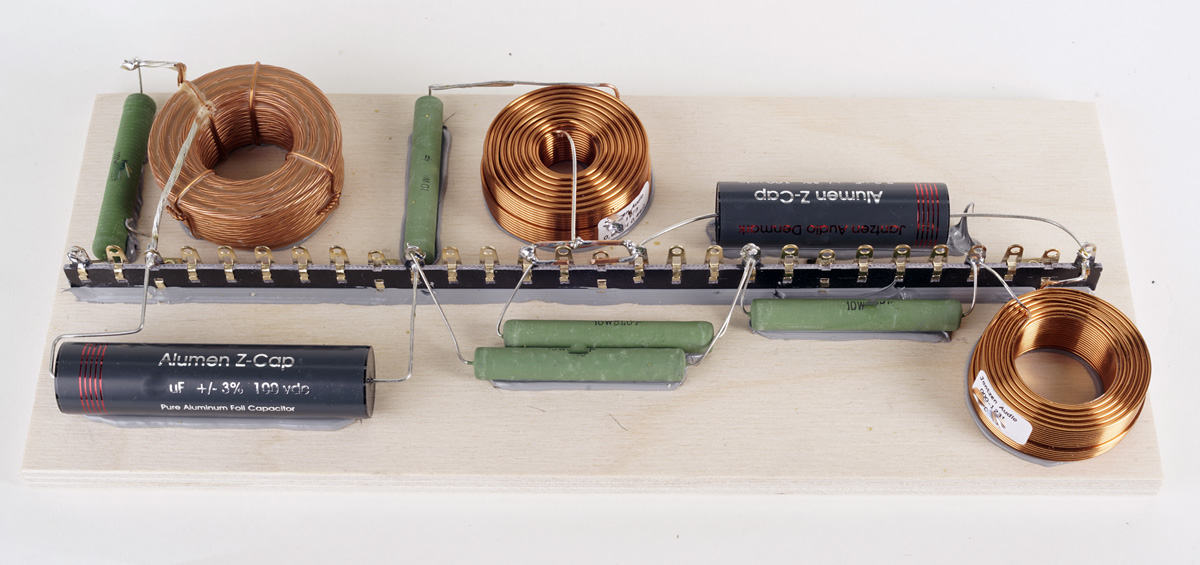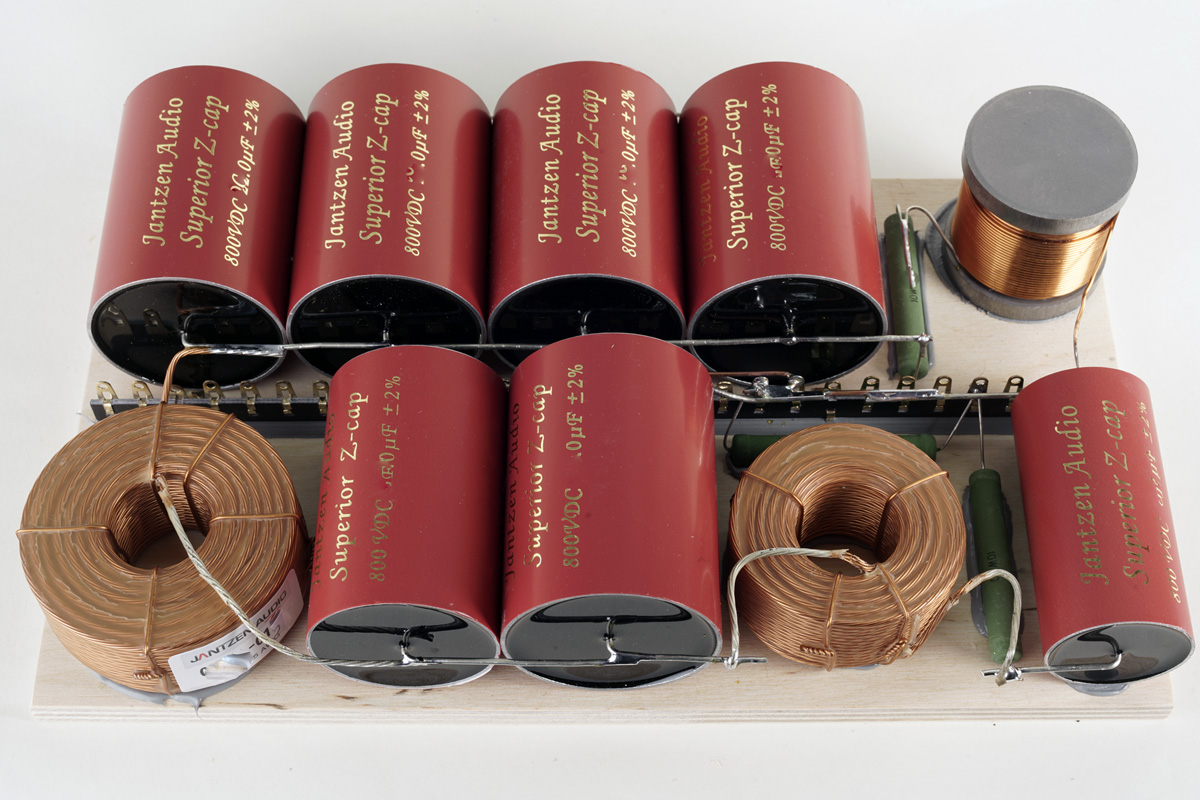DIY Loudspeakers: HOME INDEX UPDATES RESPONSE WHAT'S NEW
The Loudspeaker, TL-1
Copyright 2018-22 © Troels Gravesen
Go to on this page:
DRIVERS
CROSSOVER
CABINET
MEASUREMENTS
SPEAKER-KIT
CROSSOVER LAYOUT
March 2020:
February 2020 I launched my second version of The
Loudspeaker, featuring reduced cabinet width and some changes to the
midrange and bass crossovers. Go to
TL-2. Some of the experiences from my TL-2 has been
transferred to this first version, like more super-tweeter options and
the use of the Hypex FA501 for the semi-active version. The latter
allows the signal to be taken from the speaker cables, making it a much
easier implementation.
As said in the TL-2 article, if you have room for TL-1, then build this.
The TL-2 is 10 cm less wide and at least in our living room it just
looks significantly smaller. For my TL-2 I used an insane amount of money on
capacitors, otherwise they are identical.
The TL-1 here has been updated with more super-tweeter options and there
are changes to the passive bass crossover as well making it an easier load on
your amplifier in case you have one or two amps (bi-amping) running the
speaker in fully passive way.
June
2018:
Many years ago I had a tour at DR (Danish Radio) studios here in Aarhus,
Denmark. In one of the studios there was a speaker system, JBL
43-something, two 15" bass drivers, probably one passive, 10" midrange
driver, horn-loaded compression driver and tweeter, probably 077.
Speakers were driven from some Citation NN amps and we were listening to
a recording coming from a 2" master tape! For heavens sake - any speaker
will sound good from a 2" master tape! What I heard from these speakers
was something I'd never heard before and never will forget although
acoustic memory is short-lived and I've been seriously disappointed
going back in time reviewing stuff I liked many years ago.
However, the JBL system 43NN range never seems to go out of fashion and
what about recreating the concept from contemporary drivers and hear
what it can do? Drivers alone are some 2100 EUR. Then add some 600
EUR for the Hypex modules running the 18" bass driver in case this is
preferred. Some 2700 € + crossover + cabinet materials is a steal.
There are two key ingredients in a 4-way system like this, the 10"
midrange driver and the compression driver plus horn. Based on client
work I had a good idea of where to look and for these two key
components. I went to 18 Sound, Italy. The 10NDA610N has a shallow cone
geometry and from specs looked like a suitable 10" midrange driver, so I
ordered a pair.
The compression driver is the NSD1095N, featuring a
coated and nitrogen treated titanium diaphragm. Read specs for more
details. From client work I know
its larger sibling, and I liked what I heard. Here the smaller 1"
version.
For tweeter I picked the Fostex FT96H horn loaded tweeter, which may
come as a surprise. I've used it before and was impressed by its
performance, and I know it has found its way into extremely expensive - and well
regarded - commercial horn systems.
For bass there are quite a few, but having good experiences on BMS
bass drivers I picked the 18N862-8 Ohm, 18" bass driver. Low Fs of 25
Hz from a PA driver and it handles 1500 watts! Very high quality driver
made in Hannover, Germany. Give it a vented box of 200 litres and it
will shake your guts! And just because it makes 95 dB, don't think it
runs from faint hearted SET stuff. Give it a couple of hundred good
solid state watts and it rocks.
Now, before we proceed I have a confession to make. 308 litre brutto volume speakers are out of the question for our living room, and where these speakers are going to be stored when finished, is something I have deliberately chosen to suppress. When they are done, they'll probably be sold, but then at least I can say I fulfilled an ambition of making a speaker like speakers should be. Large enough and efficient enough to truly reveal what's hidden in digital files and vinyl grooves. Maybe if I extend the basement, there will be room...
Scrolling down the page here, some of you may start thinking JBL 4343, 4344 and 4345, and you're right. These studio monitors are my inspiration, and let's get to my main concern immediately, because the reason for holding back on such a construction is the issue of time-alignment of of midrange driver and the horn.
To time-align - or not time-align
Do we need to time-align the midrange and
horn with steep slopes and a point of crossover around 1.2-1.5 kHz? Some will say yes,
some may say it all depends. Fact is that these old monsters deliver an
astonishing midrange/lower treble, regardless of the compression driver
acoustically being some 10-15 cm behind the midrange driver. Doing dZ on
the two drivers reveals the compression driver being 112 mm behind the
midrange driver from mounted on a flat panel. With these date put into the simulation software, we
can manage a flat frequency response from connecting the horn with
opposite polarity relative to the midrange, where a 4th order filter
would normally require same polarity.
There's the thing about frequencies in this range having a wavelength
around 25-30 cm, close to the distance between our ears, thus making it
hard for us the locate sound. Pay attention next time you hear a 1 kHz
sine wave alarm tone - and you may experience how difficult it can be to
locate the source. Thus, we may not notice the phase issues going on
here. Now, the only thing to do is to set up the drivers on suitable
baffles and make a crossover with a flat frequency response.
Pulling the horn forward some 12 cm (about half the wavelength of the
point of crossover) and connecting with the same polarity also made a
flat response. Which one sounded the best? That was really, really hard
to decide, because the horn to some extent would jeopardize the
dispersion of the midrange driver unless they were wide apart. As
always, any speaker is full of compromises.
Numerous simulations were done, more than twenty, and some of them were
set up for actual testing.
The Midrange Driver
The midrange driver caused the most trouble, in particular the 10NDA610
because of its intrinsic frequency response on the intended baffle.
Having the midrange shelving up some 5 dB around 650 Hz was trouble and
making it roll-off 4th order at 1300 Hz from a driver that easily does
up to 4.5 kHz, takes the full Monty!
It took me a long time to take my eyes off the 10NDA610 midrange driver,
because it can do wonderful things, but I was never happy with the
crossover complexity to make the driver do what I wanted. After a couple
of weeks of listening to the 10NDA610 driver, I felt sure about what
this driver could do and time was ripe to try out alternatives. Hence, a
2nd driver was tested, the 18 Sound 10NW650. This is more of a mid-bass
driver than a dedicated midrange driver but with a smooth-as-can-be
frequency response. Easy implementation. The 10NW650, which is
really meant for another project, didn't disappoint and made a smooth
midrange very well integrated with the horn, but also lacking a certain
vivid quality of the 10NDA610. Was I
seduced by the 10NDA610? Maybe. I needed more alternatives and ordered a
pair of 10NMBA520 dedicated midrange drivers, a sibling to the 10NDA610.
The 10NMBA520 features a smaller voice coil,
lower Fs, goes a bit deeper and you can never know what happens to
performance from even small changes like these.
The 10NMBA520 turned out to just what I had been looking for - and
wanted to hear. Smooth frequency response, easy crossover and the sound
similar to its sibling.
As expected the horn was easy and two basic topologies were tried. First
a 4th order high-pass at 1300 Hz and a 4th order low-pass at 5 kHz. Next
a 4th
order high-pass at 1300 Hz and a smooth 1st order low-pass roll-off
towards 10 kHz, transcending to a 2nd order roll-off.
Tweeter was obviously modeled to complement these conditions. For the
latter option the
tweeter was given a 2nd order high-pass filter resulting in a point of
crossover around 9 kHz with inverted polarity relative to the horn.
Having a 2nd order filter at 9 kHz calls for some serious crossover lobing,
but I wasn't able to hear any problems from this. In fact, the horn
handles all of the treble range that matters. What the Fostex
adds is airiness to the overall sound, but there really isn't much
energy above 9 kHz.
Looking at the
JBL 4344 mkII filter they have a 3rd order filter to the 077 tweeter.
Fortunately I have frd and zrd files from such tweeter and from modeling
I can see they had a 3rd order filter providing a 4th order roll-off at
8 kHz, exactly what they
specify.
And by the way,
I wonder why JBL chose a point of crossover between bass and mid at 340
Hz. This is very high to present standards and makes the 18" bass driver
handle all of the lower midrange. I'd rather stick to having one driver
handle all of the midrange, 160-1280 Hz, or at least as much as
possible, hence a point of crossover at 200 Hz, despite the extra cost
in good uFs.
The sound?
Hmm... In terms of dynamics and transparency it beats anything I've made
before. This even from speakers twice the building price. Price to pay
is size - and weight, not to forget! I had to call in a couple of bodies
to help getting the speakers to our living room. Size matters and none of these drivers have to work hard to do
the SPL. The 18" bass drivers hardly moves delivering thunderous bass.
The midrange is as dynamic and transparent as can be and the compression
driver delivers a resolution and lack of distortion that leaves even the
best of domes behind. Say no more!
Some of the design features here build on client work and one of them
had a visitor claiming the sound being too dynamic! How can a
speaker be too dynamic? One thing we've been very good at over the last
50 years - since the days of JBL/Altec/Klipsch and others - is killing the
dynamics of reproduced music, and I guess many people have gotten accustomed to dull and lifeless reproduction or maybe never
realise that most of live
concert dynamics can be had at home. I fully acknowledge that most
people may not want home reproduction as dynamic as live
concerts.
The horn and the tweeter only takes a few uF of good caps. The midrange
takes a lot of good uF, but there is no way around it if we want to hear
it all. From the midrange and up you should feed it from the best of amplification you can
afford. This speaker will seriously display any deficiency in
amplification and source material. Bad CDs and vinyls will sound just
what they are!
The good news is that you don't need a huge amplifier to run the MTT
section. My
32
wpc tube amp is more than enough and the bottom driven by the Hypex
module with its 500 watts is well taken care of. In my test set-up I ran
the bass section from my
Hypex
UcD amp - with the passive crossover. I can't say one way is better
than the other. Don't even think the simple passive crossover for the
bass driver kills dynamics. It doesn't!
Getting the speakers into our living room and start digging into my
record collection was a quantum leap of revelation. Recordings that had
previously been "problematic" and subject for unpleasant comments to the
producer, all of a sudden came to life and embarrassingly told the story
of how weak a link speakers can be, how much membrane area is really
needed to deliver the true dynamic of most recorded music and how much
is lost in poor energy transfer. The key elements in all this is the 10"
midrange driver and magnificent 18 Sound compression driver and horn
with its exceptional dispersion. You can have a four-seat sofa in front
of these speakers and all enjoy the presence and phenomenal transparency
in midrange and treble. Good bass can be made in many ways as well as
the airiness delivered by the super-tweeter in the upper octave. Not so
critical. Getting the 200-10000 Hz range right is what counts.
After a long afternoon session with a visitor we both noticed no
listening fatigue after several hours of quite loud playback levels. A
good sign of very low distortion. Distortion can measured as content of
2nd, 3rd, etc. harmonics, but I think there's more to distortion than
that. How drivers with limited dynamic headroom smears detail and
colours sound may on a more subconsciously level be the reason for
listening fatigue as we have to spend energy listening for qualities
that should be there, but just isn't. Here we don't
have to engage in listening, we can just listen, drink our
coffee, eat our cake and enjoy whatever our cartridge is able to pick up
from the grooves - and by the way, when CDs are really good, they sound
good here too.
As said above, I've been seriously disappointed going back in time
reviewing stuff I found great many years ago, but that unforgettable
memory of the JBL system at Danish Radio some 30 years ago turned out to
be valid. I may not have a 2" tape machine, but I believe I have better
amps and cartridges compared to back then and I also believe the 18
Sound compression driver and horn betters the LE85/H91 from back then.
Useful links (Please read before writing!):
http://www.troelsgravesen.dk/tips.htm
http://www.troelsgravesen.dk/crossovers.htm
http://www.troelsgravesen.dk/LCR-RC.htm
http://www.troelsgravesen.dk/Inverted-Polarity.htm
FAQ (Please read before writing!):
You cannot change cabinet front panel dimensions and drivers' placement
without needing a new crossover - and I cannot help.
You cannot use any other drivers with the crossover specified.
http://www.troelsgravesen.dk/crossovers.htm
http://www.troelsgravesen.dk/choices.htm
Basics:
Four-way floor-stander from 18" +10" + 1" comp. driver + horn-loaded
tweeter.
Finished speaker weight: 85 kgs/ea.
Sensitivity: 95 dB/2.8V/1 meter.
Impedances: MTT section: 4-8 Ohms, minimum 4.3 Ohms @ 600 Hz. Bass
section 8 Ohm, minimum 6.5 Ohms @ 25 Hz. If run fully passive from
one amplifier, minimum impedance will be 3.0 Ohms @ 120 Hz.
Points of crossover: 200, 1300 and 9000 Hz.
Bi-amping is highly recommended if no Hypex module is used (passive
version).
Cabinet dimensions: 65 x 45 x 105 cm (WxDxH), 307 litres gross volume.
Power requirement: 30+ watts for mid-tweeters section. 200+ watts for
bass.
Power handling: A lot! Please also read this:
http://www.troelsgravesen.dk/power-handling.htm.
Your ears will bleed before your amp blows, so take care! Tinnitus is a
serious disorder!
Download specs:
Tweeter 1:
Fostex FT96H
Tweeter 2:
GRT-145-4 (GRT-145-4 no
longer available for TL-1)
Tweeter 3:
Visaton TL16H
Tweeter 4:
JBL 2405H (pay notice black terminal is PLUS)
Tweeter 5: JBL
077 (2405) alnico (pay notice black terminal is PLUS)
Tweeter 6:
Beyma CP21/F
Compression driver: 18 Sound
NSD1095N, 8 Ohm Go to
measurements
Horn: 18 Sound
XT1086
1st midrange driver: 18 Sound
10NDA610
Go to measurements
2nd midrange driver: 18 Sound
10NW650
Go to measurements
3rd midrange driver: 18 Sound
10NMBA520,
8 Ohm (the final choice)
Go to measurements
4th midrange driver:
JBL 2123H
Go to
measurements
Bass driver: BMS
18N862, 8 Ohm
The BMS and 18 Sound drivers were bought from
LEAN/UK.
1717£ ~2000 EUR (2020)
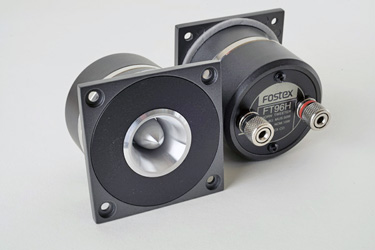
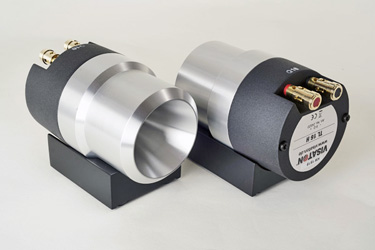
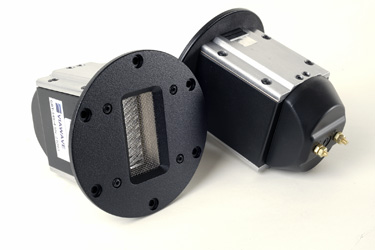
Click images to view large
Six options for super-tweeter: Fostex FT96H, Visaton TL16H,
Viawave
ribbon GRT-145-4
(GRT-145-4 no longer available for TL-1), JBL 2405H/077 Alnico and Beyma CP21/F.
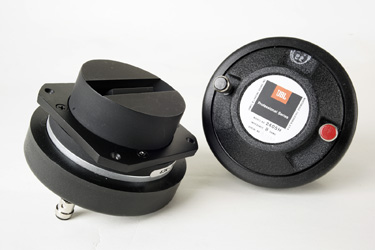
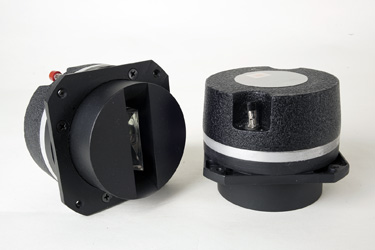
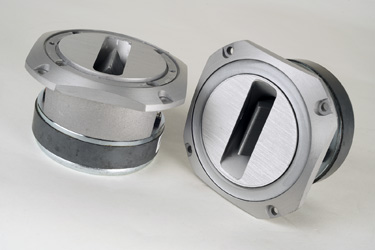
Left: JBL 2405H. Black terminal is
PLUS! Middle JBL 077 ALNICO. Right:
Beyma CP21/F.
Check measurements of super-tweeters
here.
Check out Beyma mods
here.
PLEASE DO NOT ASK WHICH SUPER-TWEETER IS BEST!
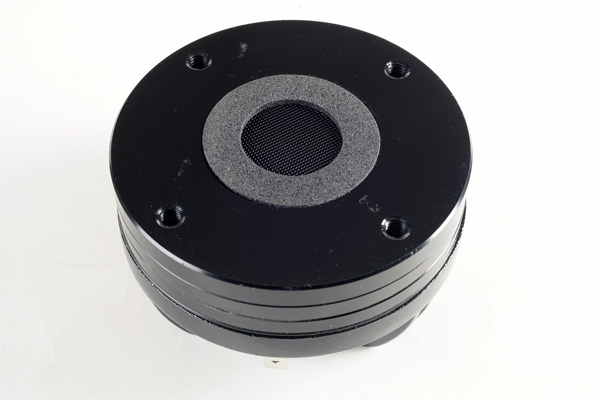
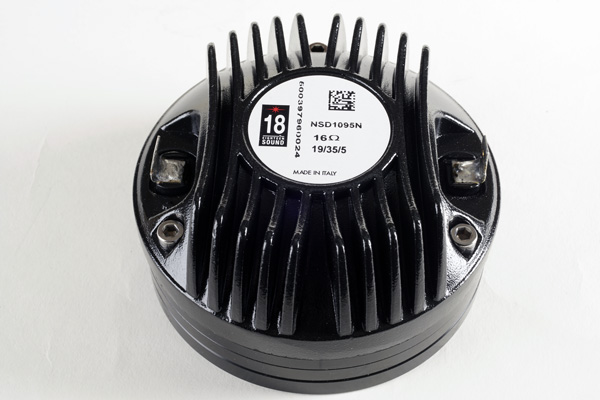
Compression driver, 18 Sound NSD1095N. For the construction here I
used the 8 Ohm version of NSD1095N.
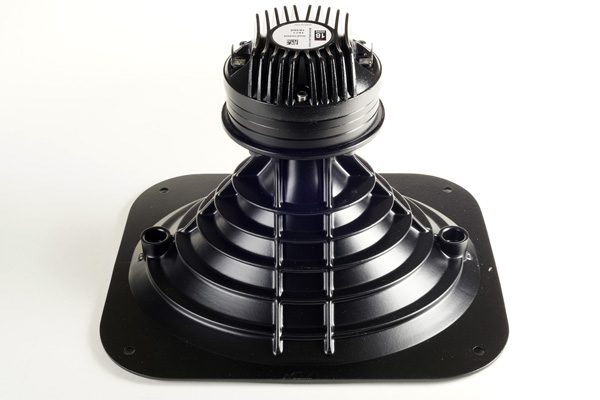
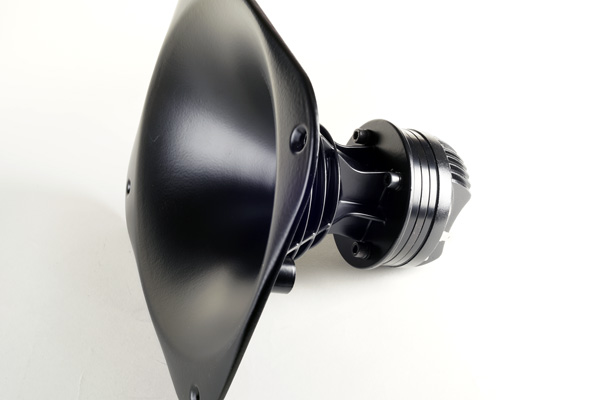
Cast aluminum horn, 18 Sound XT1086
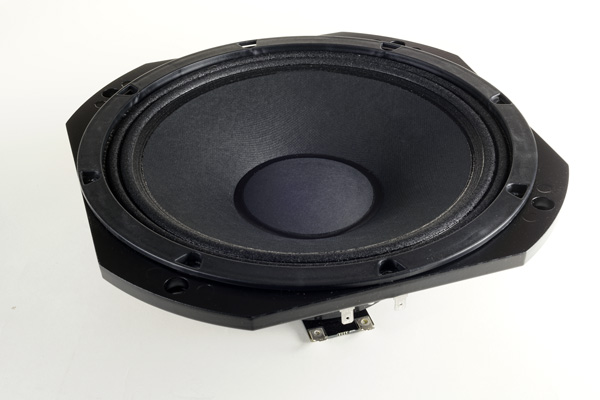
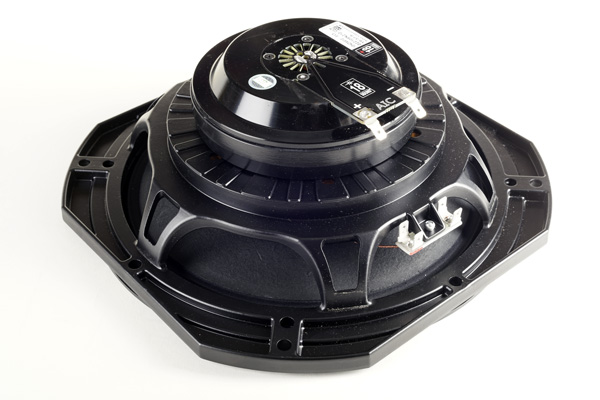
Above the 10NDA610 midrange driver. A midrange driver on steroids!
Phenomenal driver, but picky on baffle design.
Click images to view large
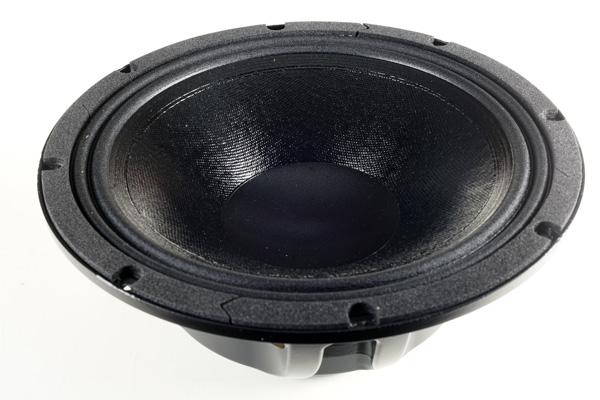
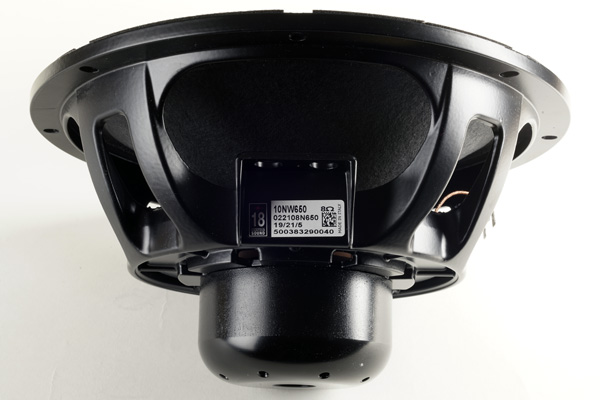
The second driver in line for midrange is the 10NW650. This may be a
more typical mid-bass driver, but on this baffle a much smoother
frequency response and subsequently a much easier crossover. I bought it
for use in an "ATS4-HE" bass bin standard set-up together with the BMS
12N630 - and I'll use it there. This bass section is suitable for a
range of midrange-tweeter tests. Maybe I'll use it for a smaller version
of this speaker with a 15" driver. Have a 15" Ciare bass driver that
needs company.
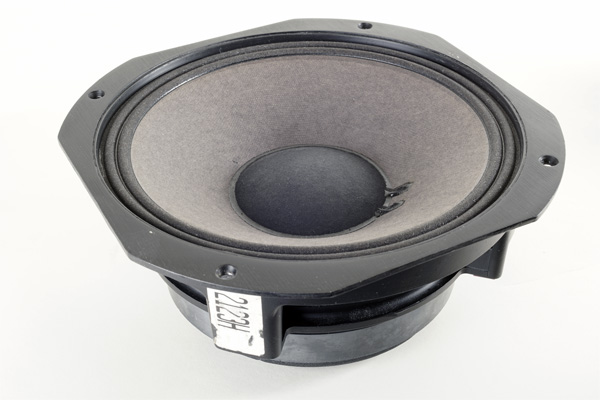
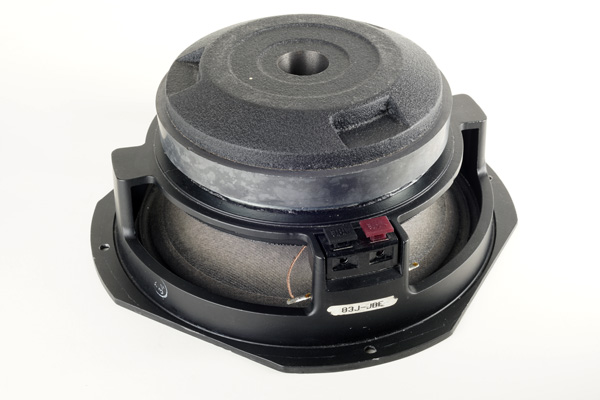
JBL 2123H midrange driver.
This JBL driver was tested more out of curiosity than from any intention
of using it in this construction, but I wanted to know how the original
midrange driver was performing. Results below under measurements. I
found them at reasonable price and they appear to be in mint condition,
no sagging of the spider or anything not performing as expected. The
2123H is actually a little smaller than the two 18 Sound midrange drivers, about 10% less cone
area.
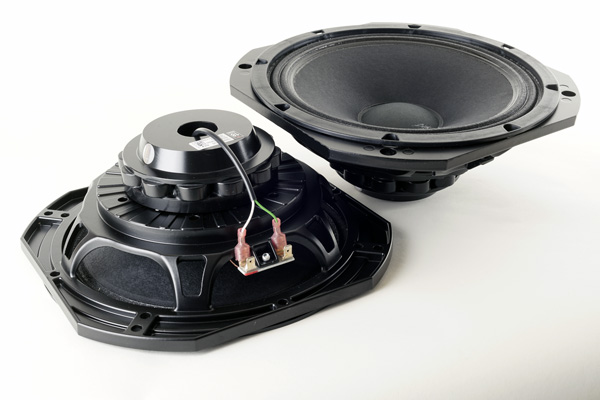
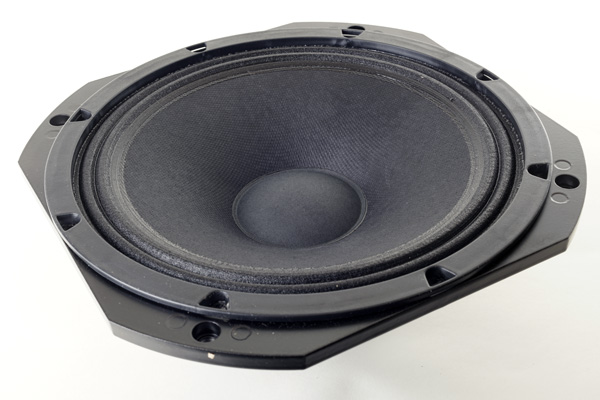
The 10NMBA520 midrange driver. The final midrange driver.
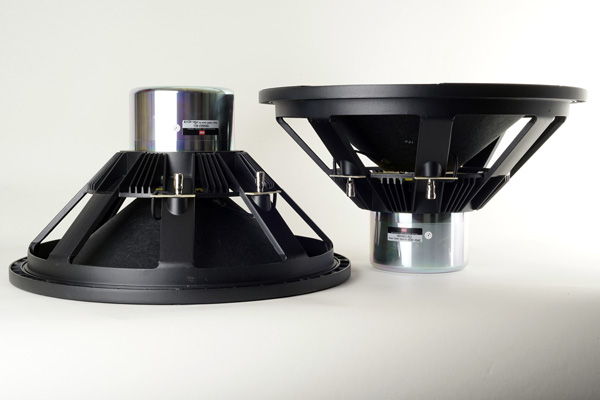
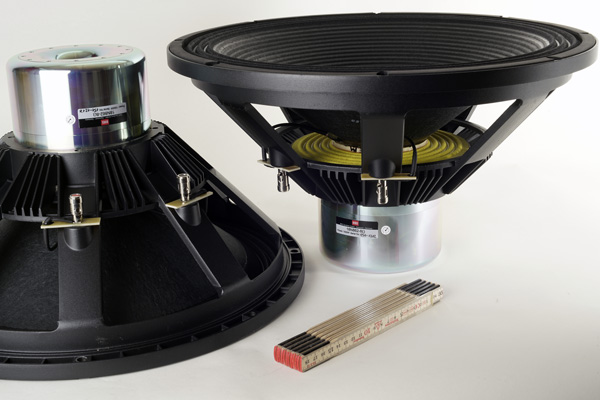
BMS 18N862. The images hardly convey how gigantic these
drivers are.
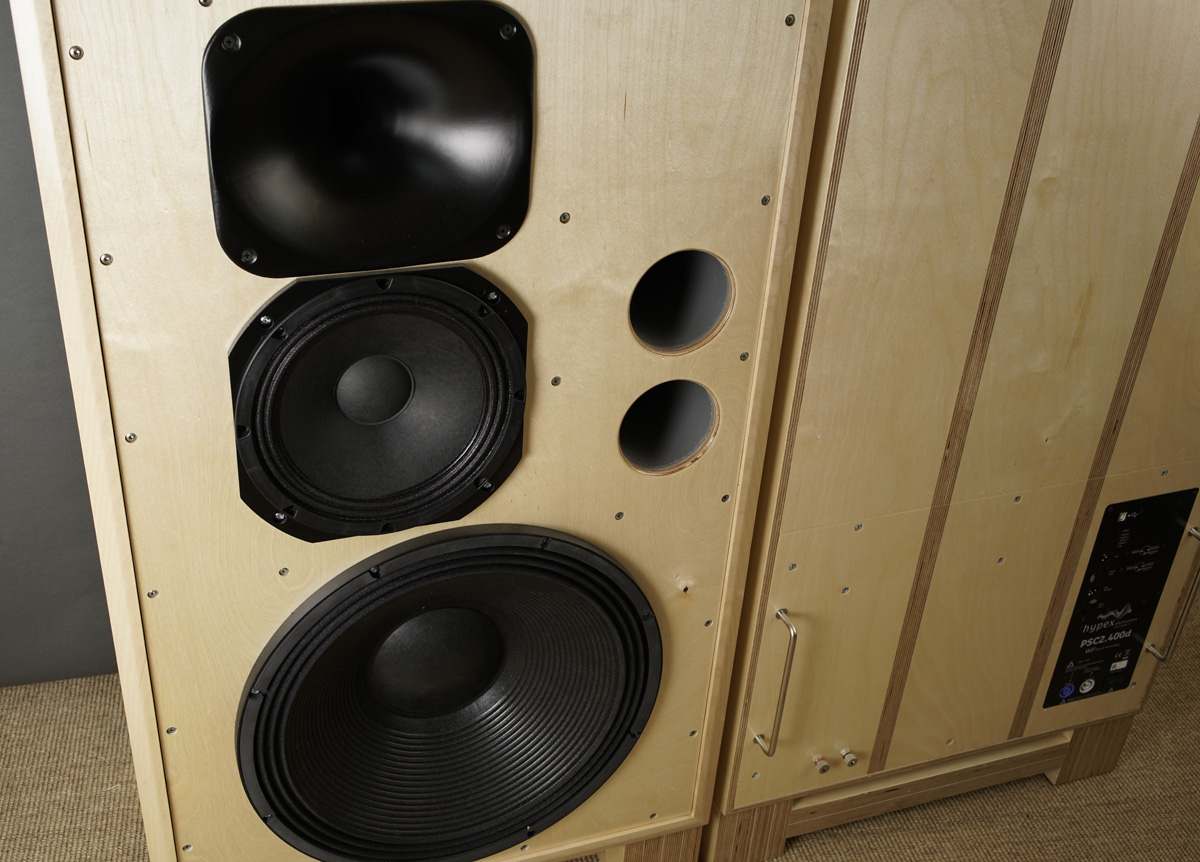
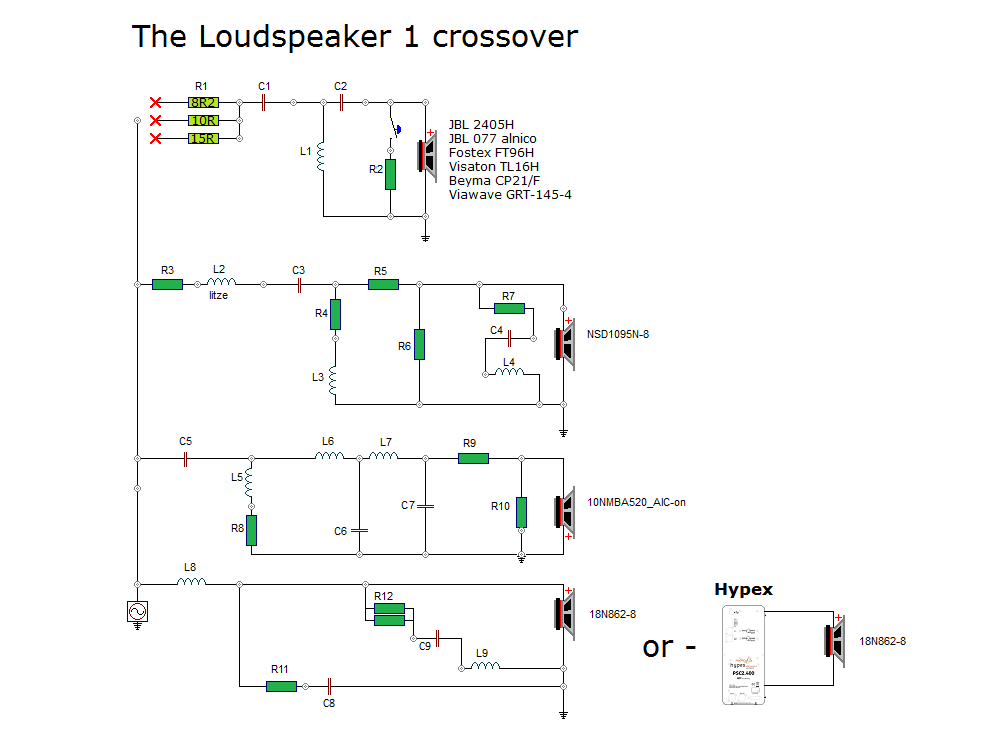
Crossover schematics. Values come with the kit.
The super-tweeter runs from a 3rd order filter creating a 4th order
roll-off, creating the best integration with the compression driver
where a single coil provides a 1st order filter creating a 2nd order
roll-off. Now, the JBL way of doing this is placing the tweeter on the
front panel maybe some 15 cm in front of the compression driver. This
creates serious comb filtering looking something like this if I take the
FT96H to the front of the box. The 10-20 kHz range will be a series of
dips when the sound from the two drivers are out
of phase.
Ribbon tweeter GRT-145-4 use the same crossover. Move 5 mm forward
compared to Fostex (95 mm to front panel plane).
In addition to the original TL-1, I have added an LCR circuit
(R12+C8+L9) to the bass section providing a better overall impedance
when running the speaker in fully passive mode from a single amplifier.
You find the super-tweeter attenuation guidelines in the TL-2 file:
http://www.troelsgravesen.dk/TL-2/tweeter-alignments.png
The compression driver high-pass filter is created by a 2nd order filter
creating a 4th order roll-off together with the drivers inherent
roll-off towards the midrange driver, and the 10NMBA520 runs from an
almost text-book 4th order low-pass section and an LR2 high-pass filter,
thus must be connected with reverse polarity relative to the bass.
Bass features a 2nd order LR topology, either from the passive crossover
or the Hypex FA501.
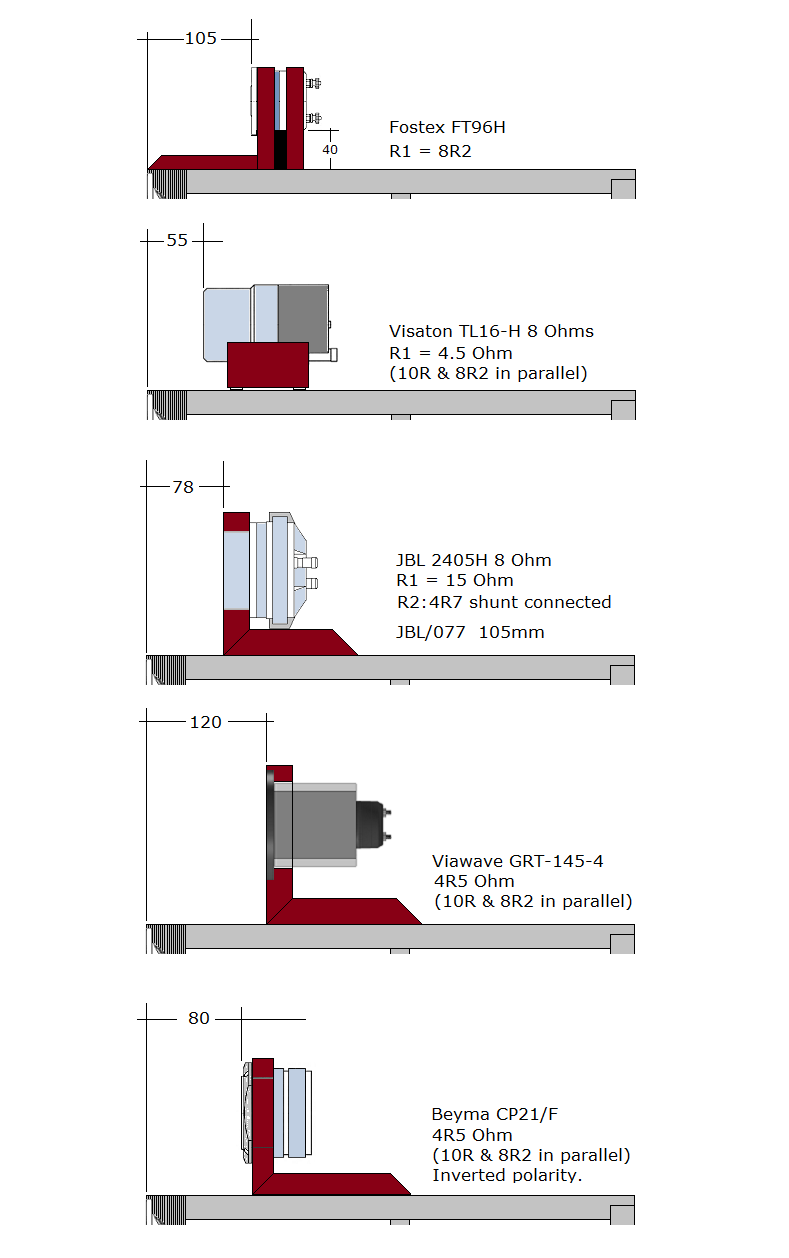
Above the alignment of the super-tweeter and subsequent attenuation.
PLEASE DO NOT ASK WHICH SUPER-TWEETER IS BEST!
It has come as a surprise to quite a few TL-1-2 builders that they can't
hear the super-tweeter. I've had numerous pictures of crossovers to look
for anything wrong in layout and wiring - and they all looked OK.
What is going on here is that you - mostly - due to age really do not
hear much - if anything - above 9 kHz!
Surprise? Well, not much we can do about age, but try disconnecting all
drivers except super-tweeter, play at normal level and put your ear to
the super-tweeter. Maybe you'll be able to hear a faint response. The
super-tweeter adds "airiness" to the overall sound, but really doesn't
contain much energy.
Hypex FUSION FA501 plate-amp/DSP
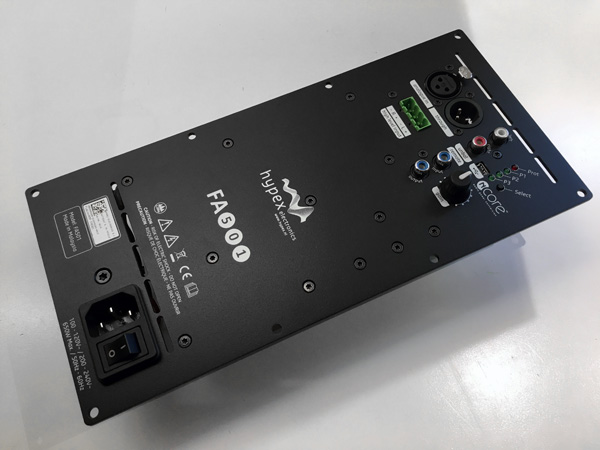
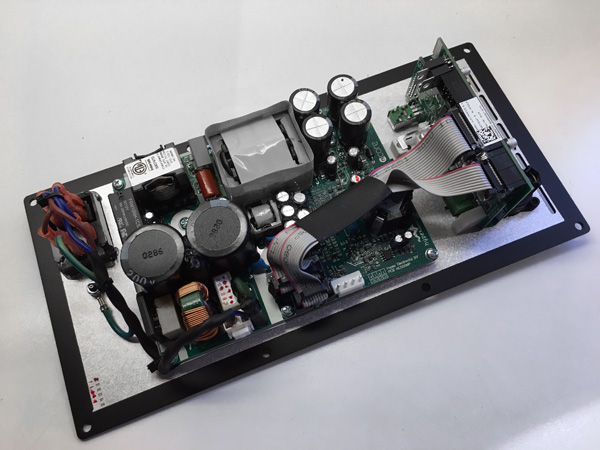
The Hypex FA501 module allow us to take the signal from speaker cables and not needing any line signal from your preamplifier - in case you may not have such - or it doesn't have double line-out facility. Go to FA501 page here.
Click image to view large.
For the ports I used Ø103 mm (internal diameter, 110 mm outer diameter) sewage pipes. 300 mm length.
This is by far the best and most rugged solution for these ports - and
cost very little. You can also make one vertical rectangular port, 19.6
x 8.0 cm, 30 cm length. I suggest you also make a vertical brace in the
bass compartment as seen from
TL-2.
After implementing the Hypex FA501 plate amp/DSP, a simpler crossover
compartment can be made as seen on the drawing above. Check out
TL-2 for further details.
Don't forget to mirror cabinets!
Obviously the cabs need some sturdy stands - very Japanese style. Here
120 mm high.
The super-tweeter distance here of 120 mm is for the Viawave GRT145-4
tweeter. See super-tweeter alignment here in TL-2 file:
http://www.troelsgravesen.dk/TL-2/tweeter-alignments.png
During construction I used wheels for moving the speakers around.
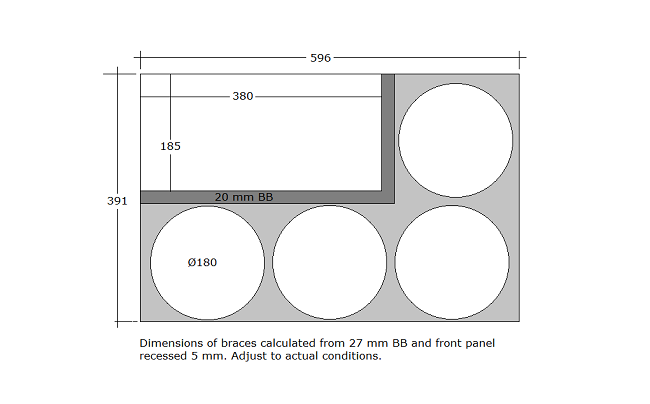
Braces, click image to view large. Adjust to fit your choice of panel
thickness.
Make sure to mirror the braces!!
As always: Any change to front panel design and drivers' placement and you need a new crossover and I can't help. Please read carefully before asking: http://www.troelsgravesen.dk/crossovers.htm
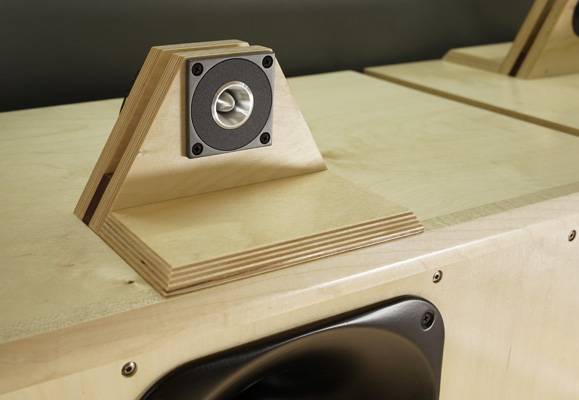

The Fostex FT96H super-tweeter support can be made to your liking as long you stick
to the center being some 60 mm above surface and tweeter faceplate 105
mm behind front panel plane.
See alignment on other supertweeters in the TL-2 file:
http://www.troelsgravesen.dk/TL-2/tweeter-alignments.png
Workshop images

Every speaker construction starts with a mockup! Falling in love with
bunch of drivers and assume they will make a wholesome family very often
is waste of money. As can be read here, three midrange drivers had to be
tried to find the best for this project. Above the midrange
drivers were placed in 34 litre closed boxes and the bass driver on a
simple U-shaped frame. Believe me, these bass drivers deliver deep
thunderous bass even from a simple open baffle. I fact I have to fix the
door fillings to my workshop as they were rattling like crazy!
In this
important stage the front panel dimensions and drivers placement has to
be correct - or as intended. Numerous crossovers were tested
before finally things fell into place. The litmus test was taking my
turntable to the workshop to make sure the final crossover was it.
Usually I take the speakers to our living room, but moving the turntable
was easier.
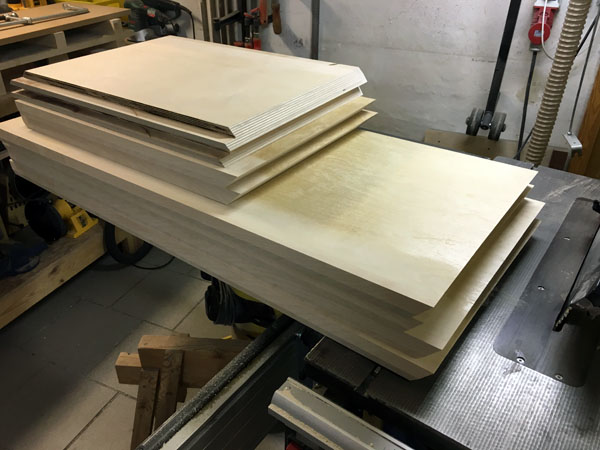
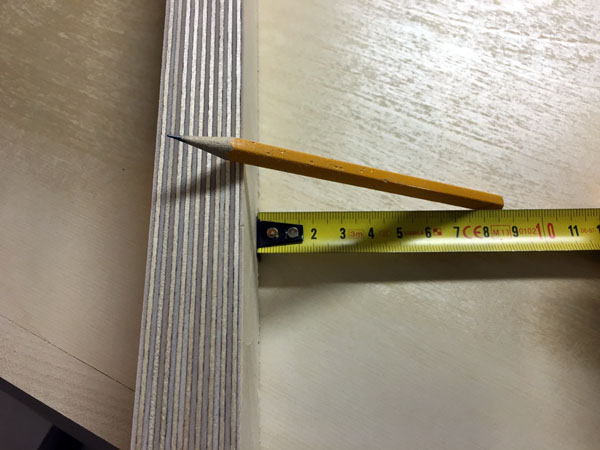
Cabinets are made from 27 mm Baltic birch* in much the
same way I would make a smaller 3-way classic. Now, a speaker this size
has its own problems, size and weight! One side alone is some 9 kgs and
once all put together you don't just flip over cabinets for sanding or
whatever. Every operation takes some consideration. The outer shell will
be some 50 kgs, and then comes bracing, mid cabinet, crossover cabinet,
Hypex cabinet, etc. I guess we'll end up around 70 kg alone for the
finished cabinet. I'll add wheels to the base frame to be able to move
the monsters around...
*I meant to use 24 mm Baltic birch and I went to my
local Baltic birch pusher and asked for four sheets of 24 mm Baltic
birch, standard 152 x 152 cm. "Sorry, we haven't got 24 mm in B/BB quality", the friendly lady
said. "OK, then what?" "We have 27 mm (?)". "OK, let me have four of these".
What she didn't tell was that 27 mm only comes in 122 x 244 cm (!). Getting these 55 kgs/ea
panels home and getting them cut up to suitable pieces for my storage
shelves took the whole afternoon!
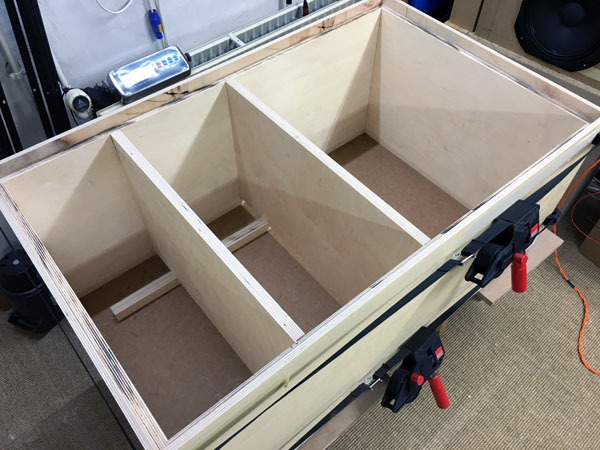
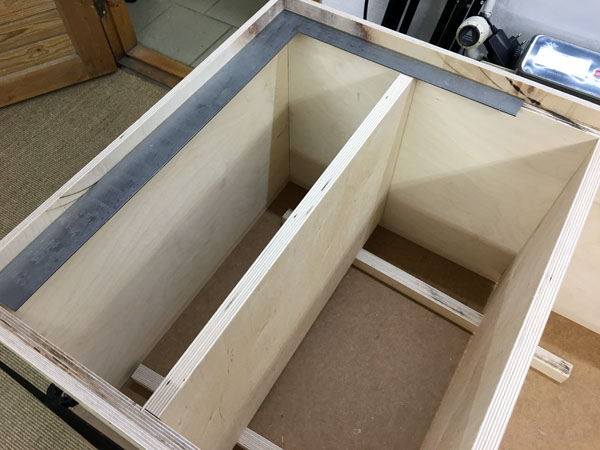
These cabs are not done over the weekend! Prepare sides, bottom and top
panels and hold together with straps like seen on image. Prepare for the
two upper braces and midrange cabinet, so this can be inserted when the
cabs are assembled. First step is gluing outer panels, two upper braces
with mid cabinet and the upper part of the rear panel in one take.
Compartment for crossover and Hypex will have to added later. It's
important not to put too many things into play at once. We have like 10
minutes before the glue starts settling. Also make sure you have large
angle square ruler! I have three of these Bessey angle strap clamps.
Make also sure you have a plane working table, here some 30 cm tall.
These cabs are HUGE and a lot of things have to be done differently
compared to the usual 10-50 liter cabs.
If you use strap clamps, add two clamps at the middle of the cabinets,
front and rear, to make sure it's 650 mm width! All of a sudden I found
out I had tightened the straps so much the cabs started bulging on the
middle being 655 mm wide. Had the glue dried, I'd been in trouble.
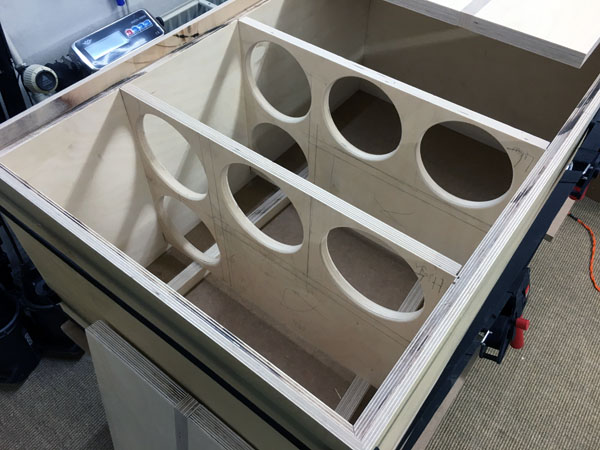
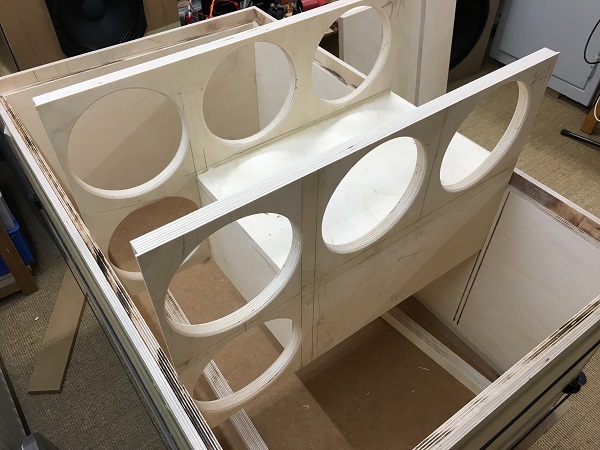
Preparing the two upper braces with midrange cabinet.
Click images above to view large.
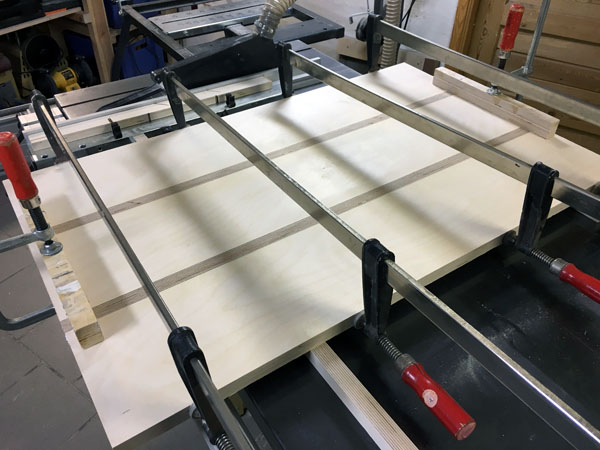
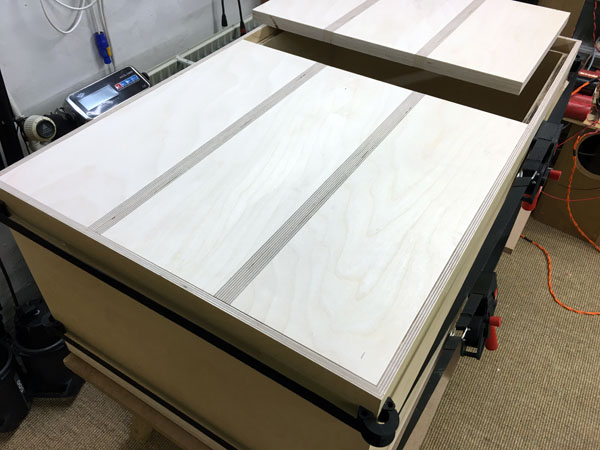
Preparing rear panel and cutting to length. The lower part of the rear
panel will be attached with screws for access to crossover.
It goes without saying that the crossover shall NOT be placed in the
bass cabinet. The pressure from the 18" bass driver is enormous.
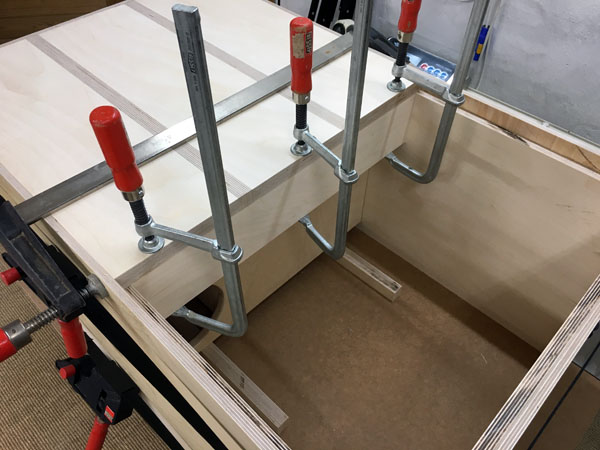
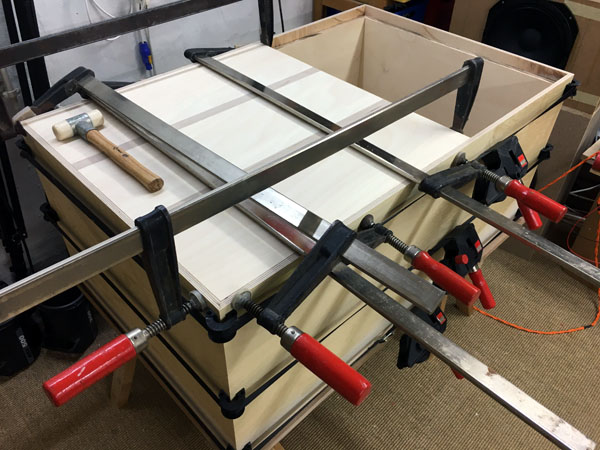
Adding upper panel in crossover housing. Gluing rear panel.
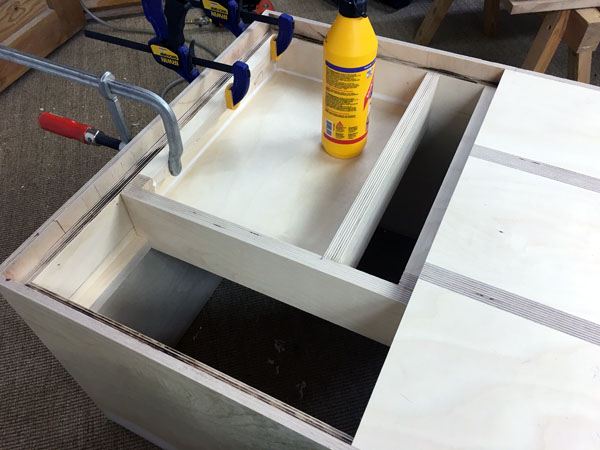
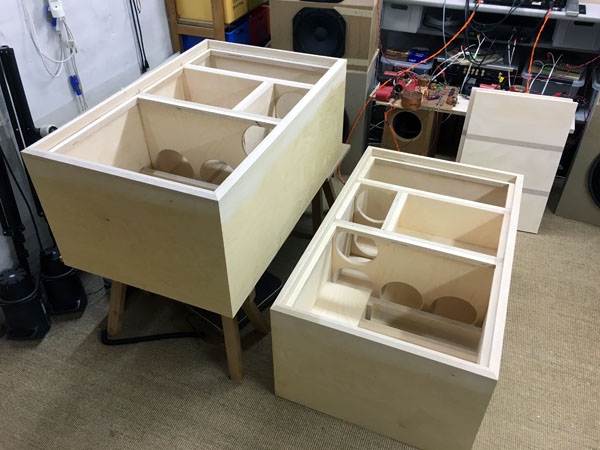
Preparing crossover compartment and adding loads of fillets. Right: All
fillets in place.
For front edges I used maple solid wood.
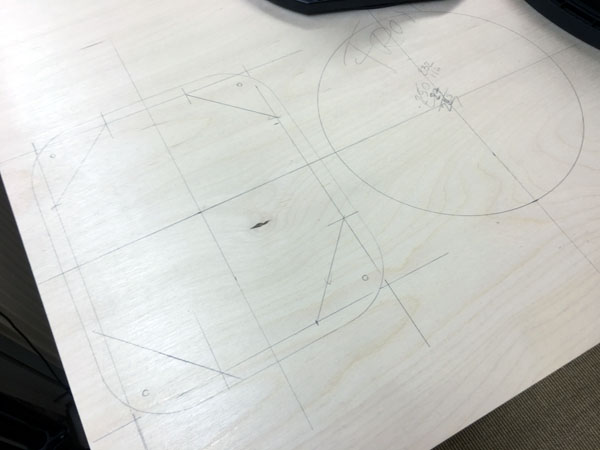
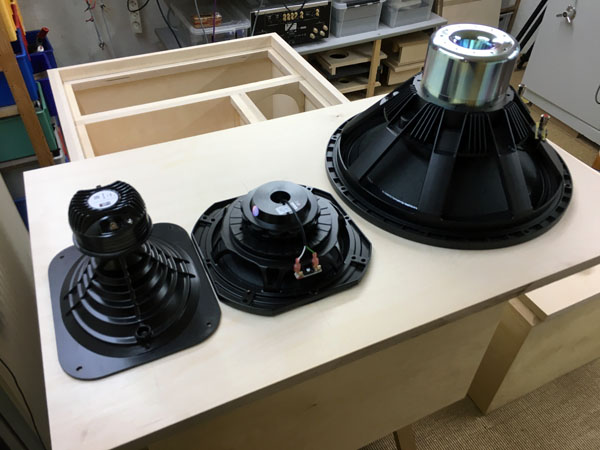
Marking drivers and preparing for routing.
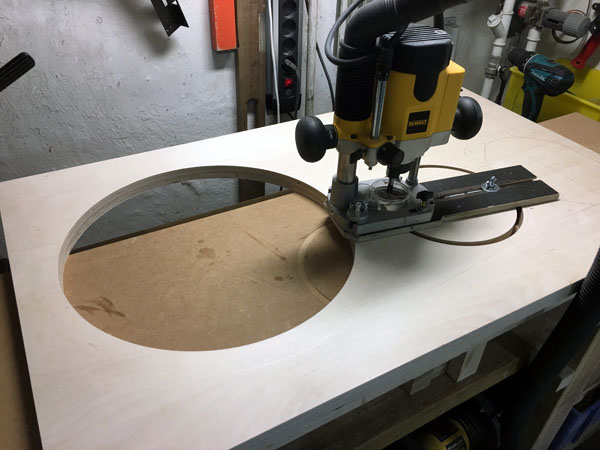
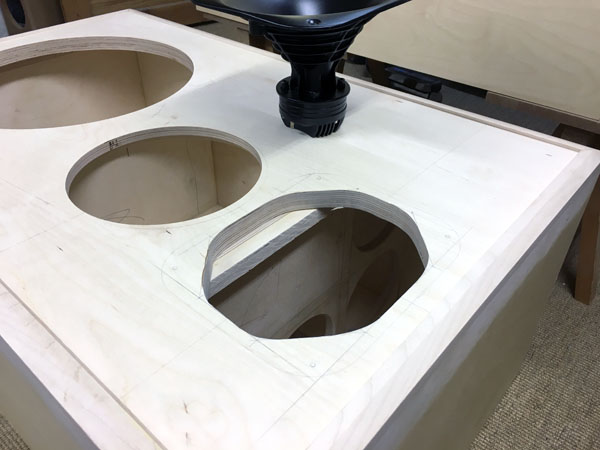
Routing and jig-sawing for drivers.
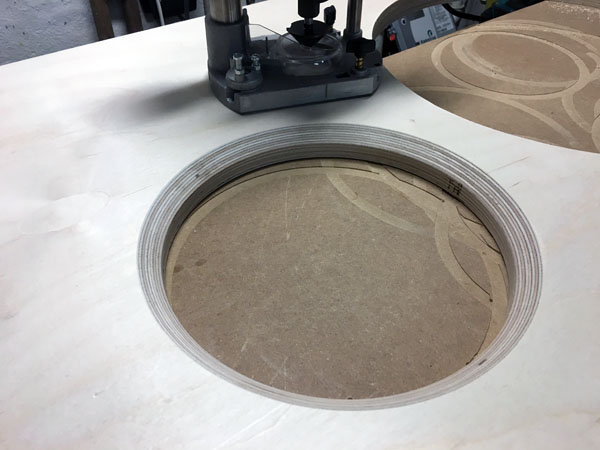
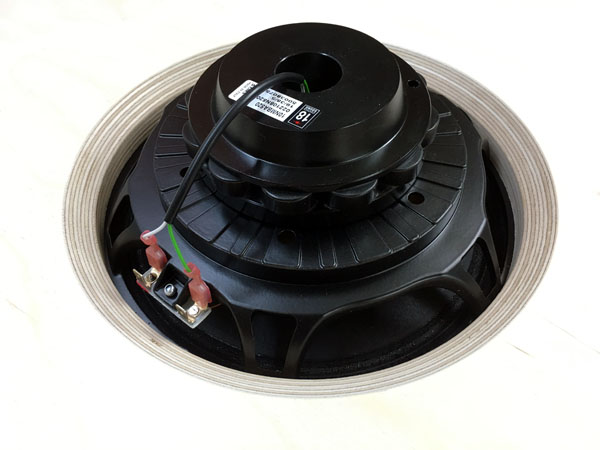
DO NOT forget to chamfer mid driver hole! 45 deg. some 15 mm deep. Bass
driver hole doesn't need chamfering, lots of space here.
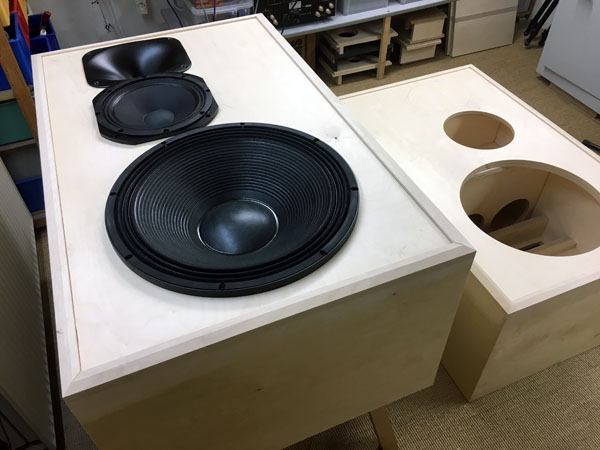
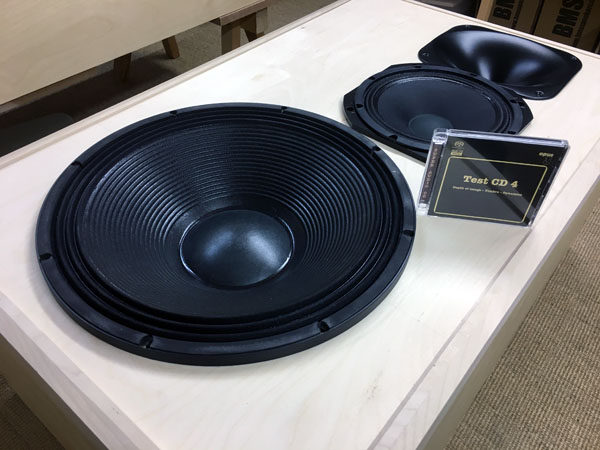
Testing driver routings. Did I tell these cabs are huge?
No need to flush mount drivers - which makes it much easier.
Screws for the heavy bass drivers do not come with the kit. Search your
local DIY home market for e.g. 5x40 mm screws.
Check
tips page.
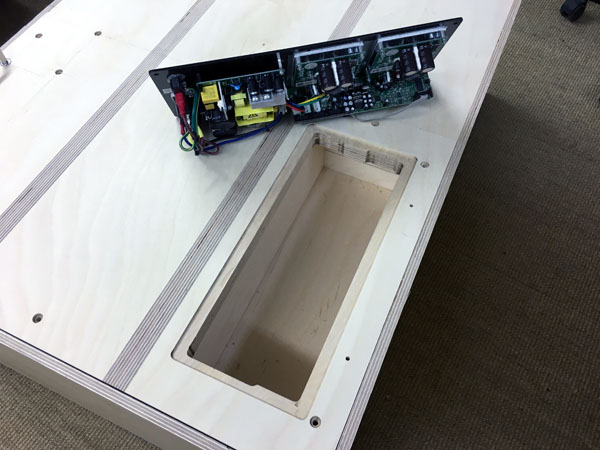
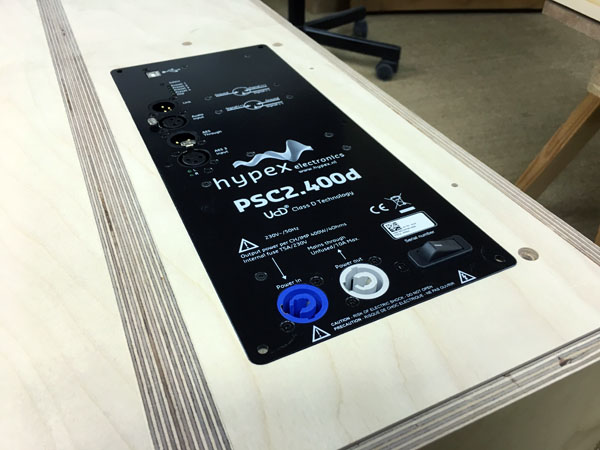
Routing for the Hypex modules. The Hypex module does not have to be
flush mounted, but it looks nice when done.
The Hypex compartment is big enough for housing this or any coming Hypex
Fusion module, except FA503, but I'm not going to use this 3-way module.
FA252 is the candidate for replacements.
Download Fusion series
here. Go to FUSION page
here.
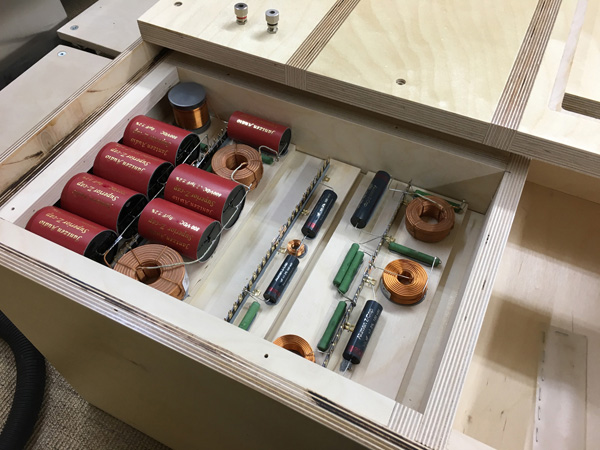
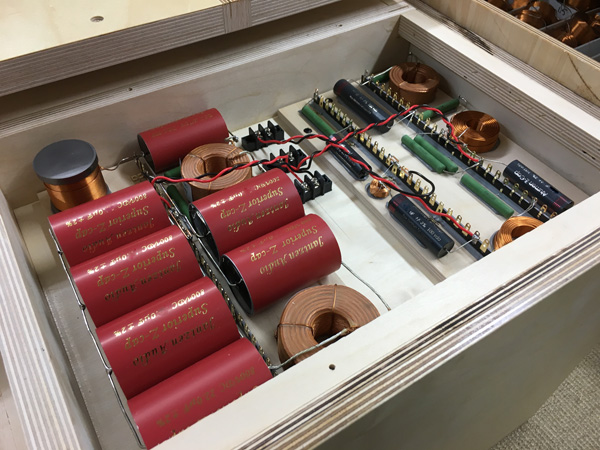
Mounting the crossovers. Click images to view large.
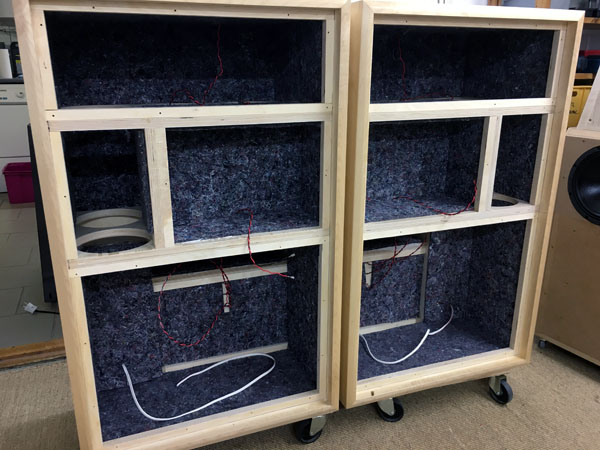
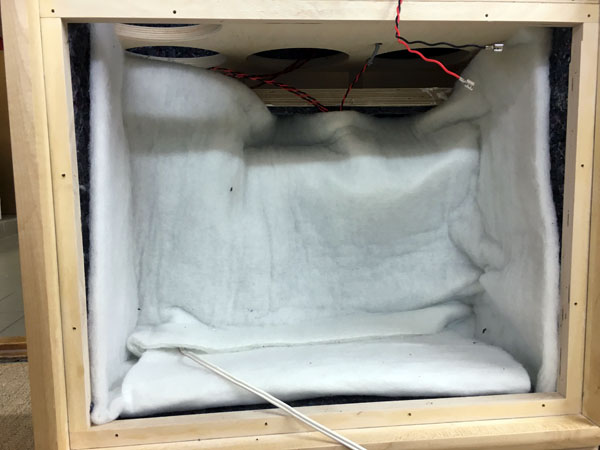
Cabinet damping. Cover all internal panels except front panel with 8 mm felt
material .
Two layers of acoustilux at bottom of cabinet. One layer of acoustilux around bass driver.
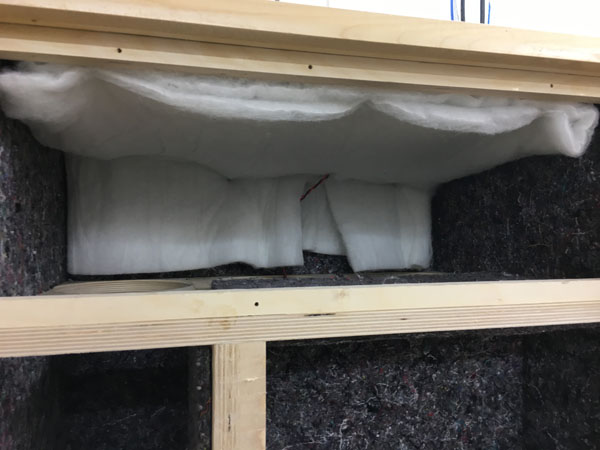
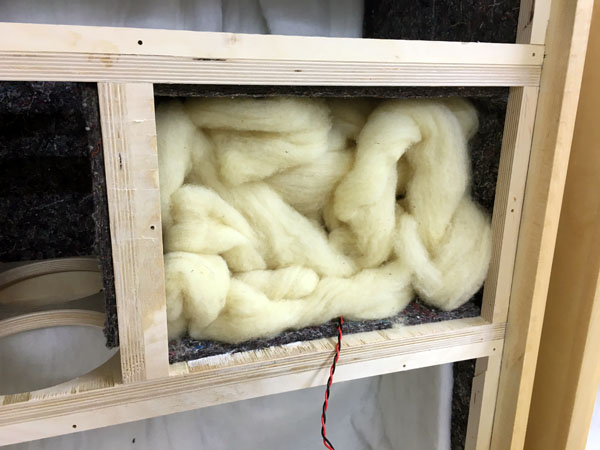
Place two layers of acoustilux at top of cabinet. Fasten with staples.
Fill midrange cabinet with wool, approx. 125 grams.
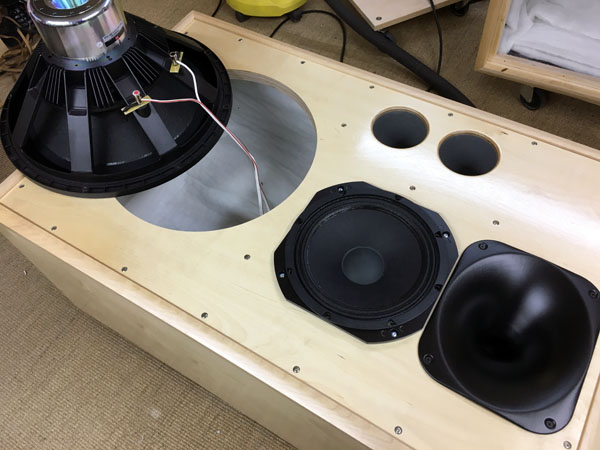
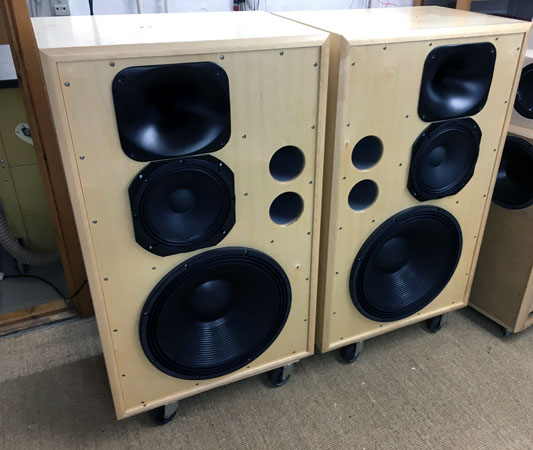
Mounting drivers - finally... The horn had a foam gasket.
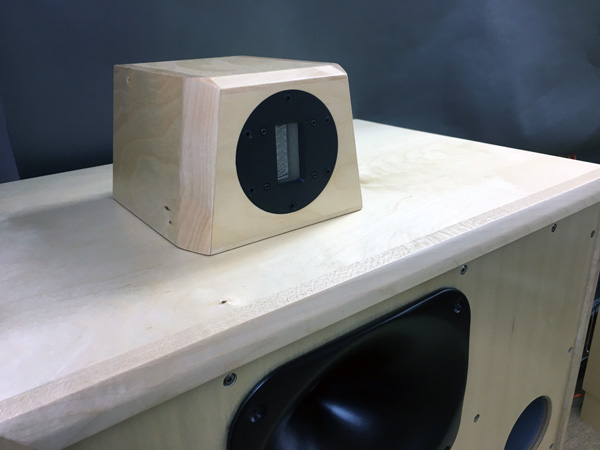
Here the speaker with the Wiawave GRT-145 as super-tweeter.
(GRT-145-4 no longer available for TL-1)
Use
ATiRi baffle dimensions and place 100 from speaker front panel.
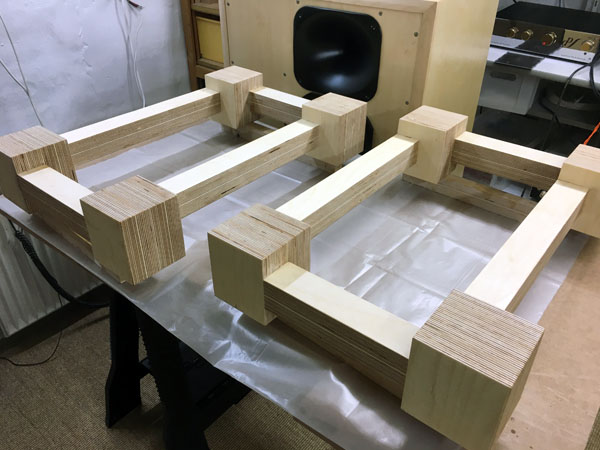
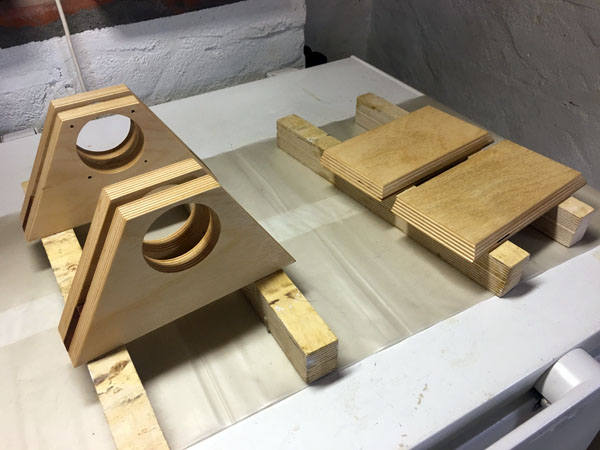
Stands for the monsters and super-tweeter support.
A few comments on MEASUREMENTS before you
start interpreting all the readings below.
First of all, if we think measurements will
tell us how a speaker sounds, we're wrong. The perception of sound is
way too subjective to be reflected in any measurements we can perform. A
loudspeaker system is meant to give us a satisfying idea of an acoustic
event and for some people a pair of 5 USD ear-plugs are enough, others
spend 200 kUSD on a truly full-range pair of speakers - and the latter
may not be happier than the former.
Measurements may give us an idea of tonal balance of a system, i.e. too
much or too little energy in certain areas, although dispersion
characteristics play a vital role here. A two-way 7+1 and a three-way
7+4+1 may display similar horizontal dispersion, yet sound very
different. Measurements may tell us about bass extension if far-field
measurements are merged with near-field measurements. In addition to
this, ports may contribute to bass extension. Most of we diy'ers do not
have access to an anechoic room for full-range measurements from
20-20000 Hz.
What cannot be seen is what kind of bass performance we get in a given
room. Bass performance is highly dependent on in-room placement of your
speaker and the same speaker can be boomy in one place and lean in
another. Actual SPL level at 1 meter distance and 2.8V input is useful
for en estimate of system sensitivity and combined with the impedance
profile may give an idea of how powerful an amplifier is needed to drive
the speaker to adequate levels.
What measurements do not tell is the very sound of the speaker unless
displaying serious linear distortion. The level of transparency, the
ability to resolve micro-details, the "speed" of the bass, etc., cannot
be derived from these data. Distortion measurements rarely tell much
unless seriously bad, and most modern drivers display low distortion
within their specified operating range.
Many people put way too much into these graphs and my comments here are
only meant as warning against over-interpretation. There are more to
good sound than what can be extracted from a few graphs. Every graph
needs interpretation in terms of what it means sonically and how it
impacts our choice of mating drivers, cabinet and crossover design.
What measurements certainly do not tell is the sonic signature of the
speaker, because speaker cones made from polypropylene, aluminum,
Kevlar, paper, glass fiber, carbon fiber, magnesium, ceramics or even
diamonds all have their way of adding spices to the stew. Nor do
measurements tell what impact the quality of the crossover components
add to the sound, from state of the art components to the cheapest of
coils and caps, they all measure the same if values are correct, yet
sound very different.
NSD1095N compression driver + XT1086 horn.
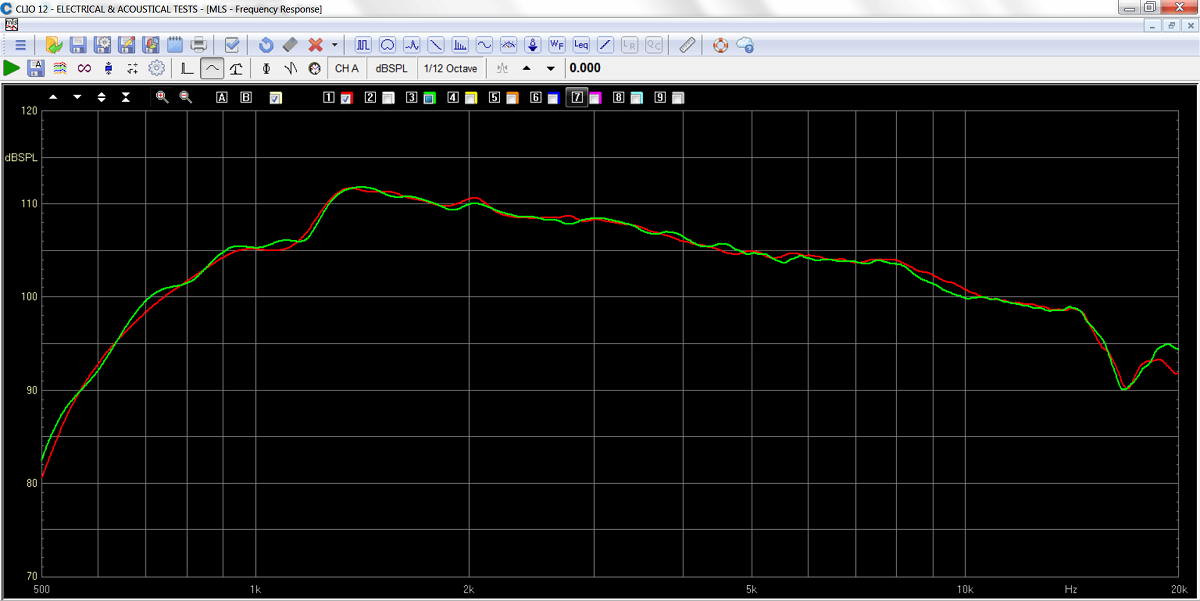
Above the NSD1095N compression driver with XT1086 horn, not mounted on any baffle.
Compared to what I've had to work with in the past, this horn is a piece
of cake and should make it easy to target a high-pass filter around
1.2-1.5 kHz.
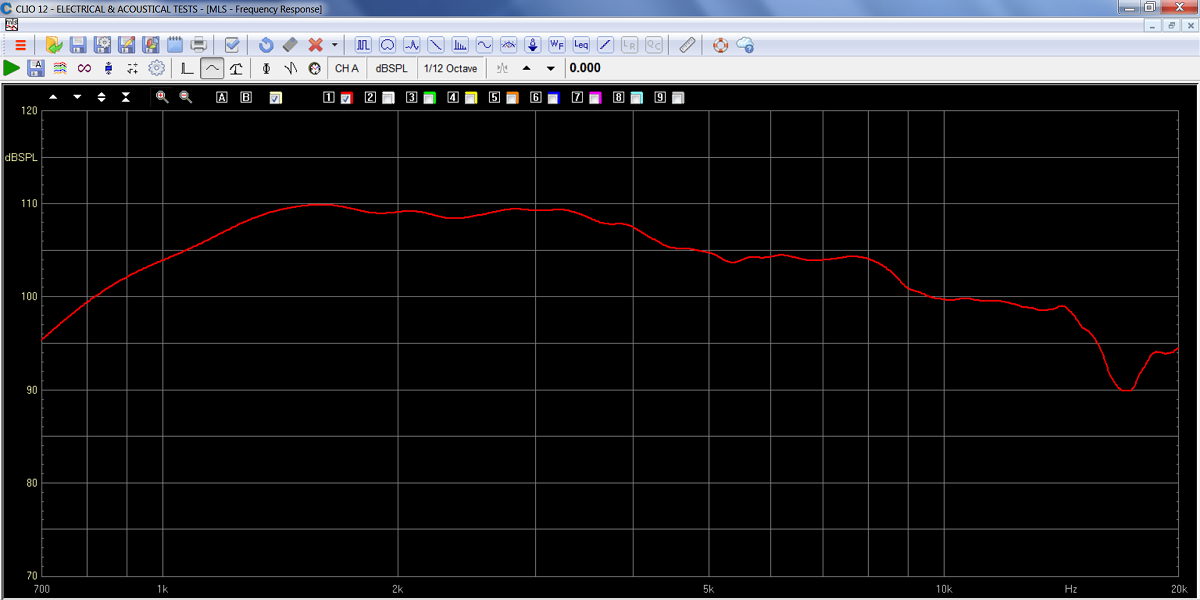
Above the horn on actual baffle. Slightly smoother roll-off towards
low-end, but also a minor bump at 3 kHz.
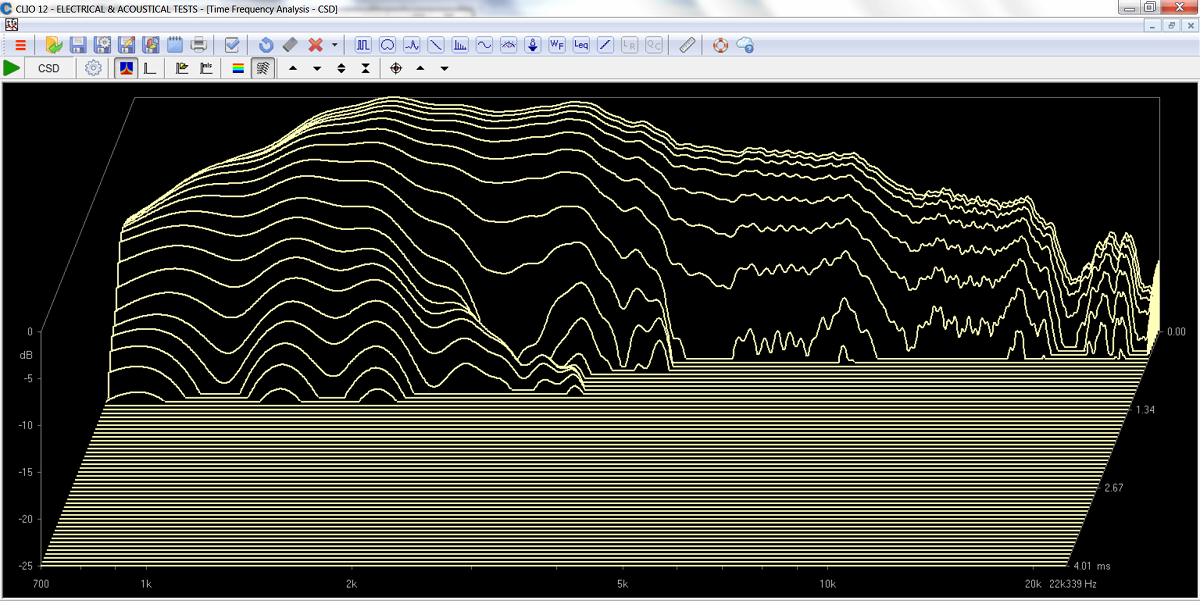
NSD1095 + XT1086 horn CSD. Kind of a clean bill, isn't it?
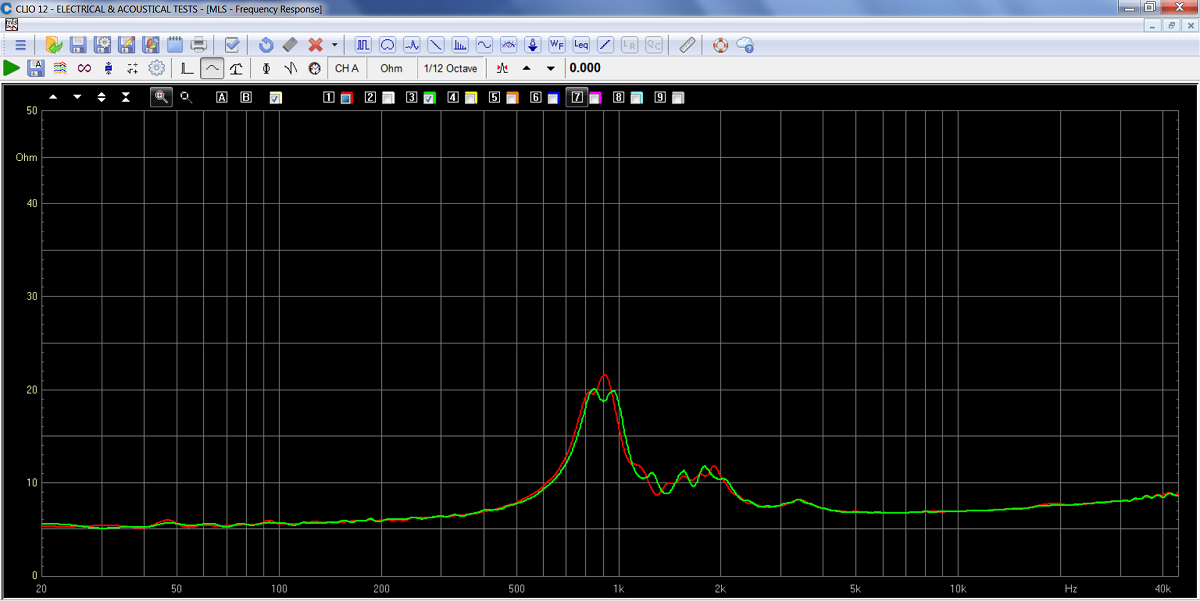
Impedance of horn-loaded compression drivers usually looks horrible,
and this is no exception, although is does fairly well above 1 kHz. I've
seen worse. But don't worry, as soon as we add attenuation like seen
below we have a nice flat impedance (red) - and we need at lot of
attenuation as it does around 105 dB/2.8V/1 meter from 1-10 kHz,
covering more than the range we'll be using it for.
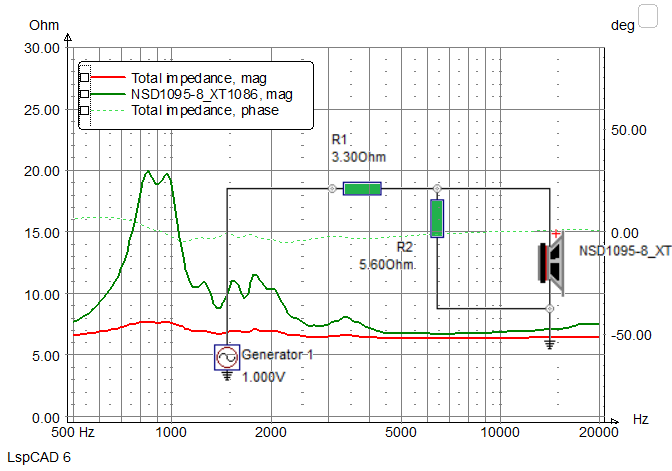
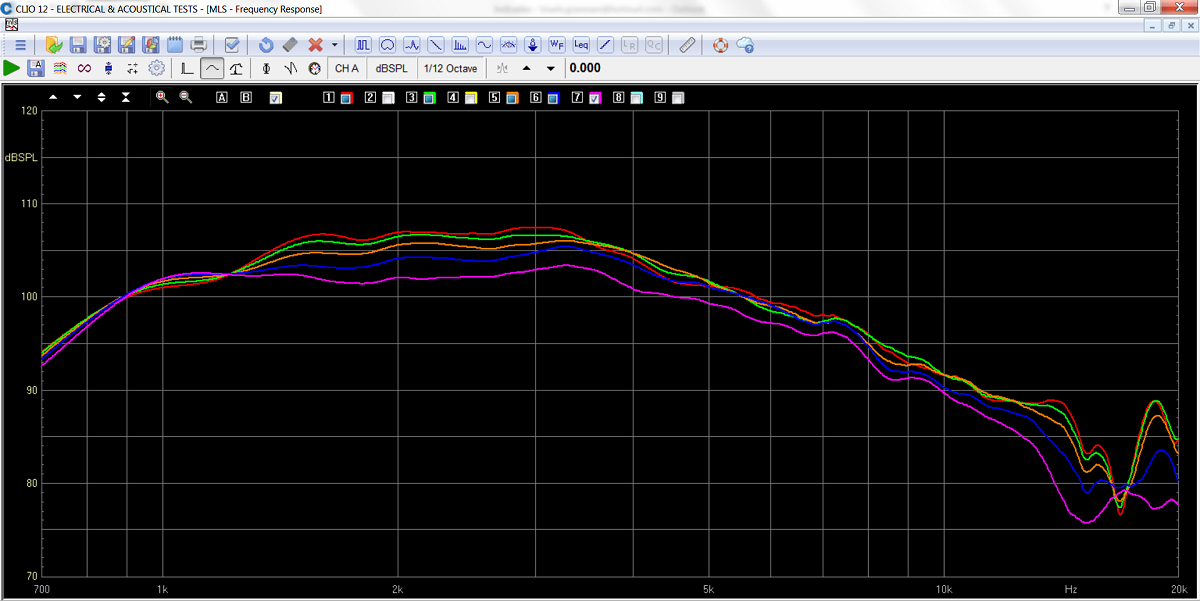
Above the dispersion of the 18 Sound horn @ 0, 10, 20, 30
and 40 deg. off-axis. Quite exceptional.
This is one reason for the four-seat listening window.
.png)
Above and below the FT96H tweeter, w/wo baffle. Green is no baffle. From a horn-loaded tweeter, the above frequency response is very flat indeed, and impedance is almost ruler flat. This tweeter is suitable both as a regular tweeter above 4 kHz and as a super-tweeter, should to fancy frequencies above 30 kHz. Here the intension is to have a point of crossover at min. 5 kHz. My microphone is not linear up to 40 kHz, so level will be higher above 20 kHz.
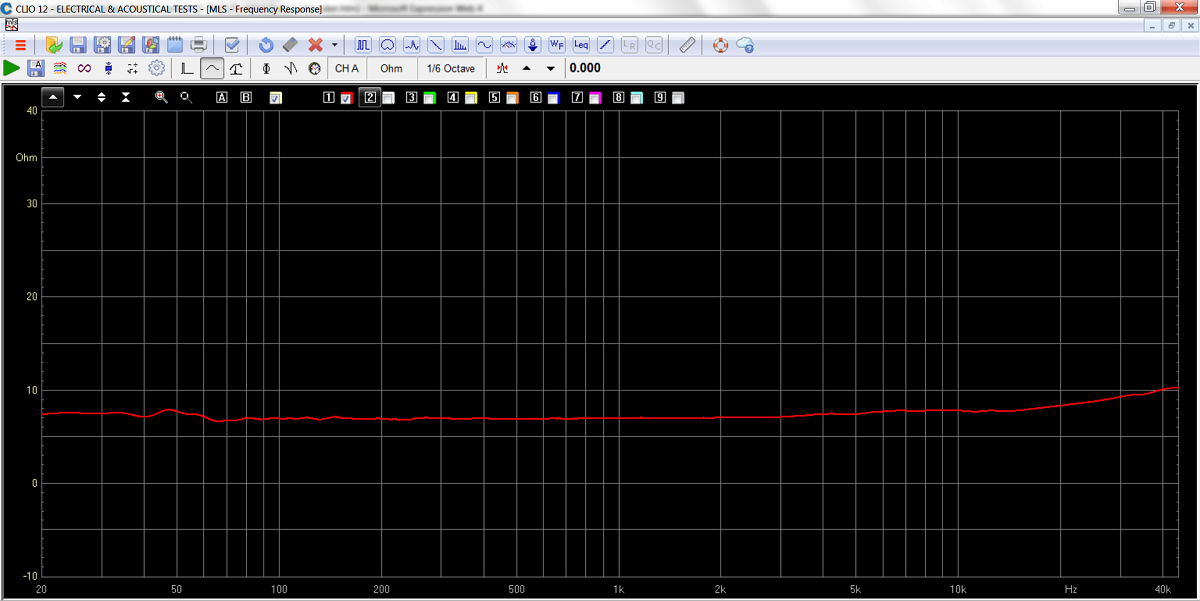
FT96H impedance.
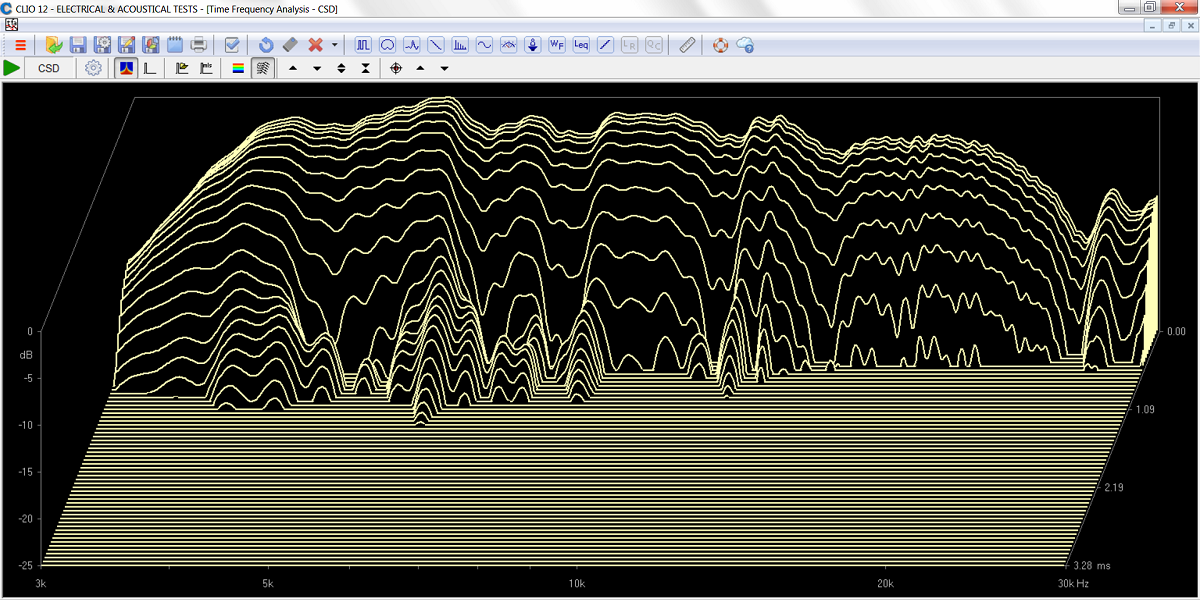
FT96H CSD from 3-30 kHz.
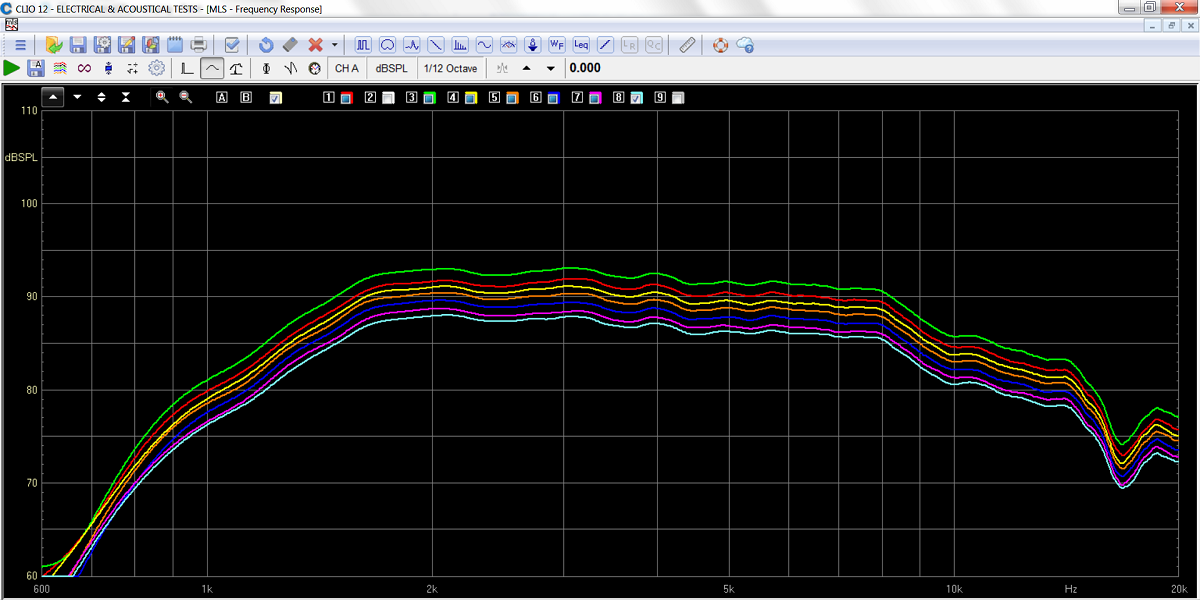
Impact of 20 watt attenuator from 0, -1, -2, -3, -3, -4 and -5 dB. This
seems to work very well indeed.
Now, attenuators may have a bad reputation because the wipers may get noisy over the years. True, but when they work I cannot to the best of my ability hear any degradation of sound as such. Usually we would tune the actual driver 1-2 dB higher than ideal to allow some working space around the attenuator. If you want to use an attenuator for the horn, increase R6 to 10-12 Ohm and insert the attenuator like this:

Fostex has a range of attenuators that look good - and they are not
exactly cheap. Check file
here. The smallest is 100 watt and is more than
enough. Check eBay for alternatives. This 50 watts
here looks nice.
eBay search:
"L-Pad attenuator" They usually range from
6-25£/ea.
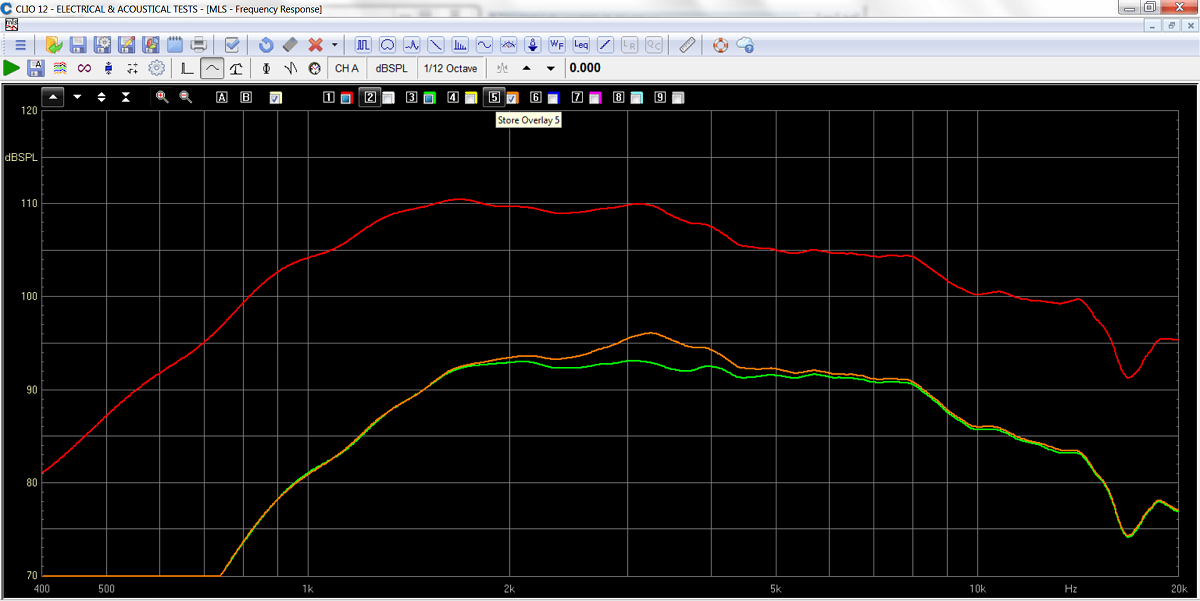
Compression driver with horn. Red = no crossover attached. Orange =
response driven from crossover without LCR circuit.
Green = response with LCR circuit.
Getting rid of the 3.3 kHz bump is crucial for getting a smooth treble
without listening fatigue.
The midrange drivers
As can be seen above, a range of midrange drivers were tested to find the best sounding and the one with the best technical performance on the given baffle.
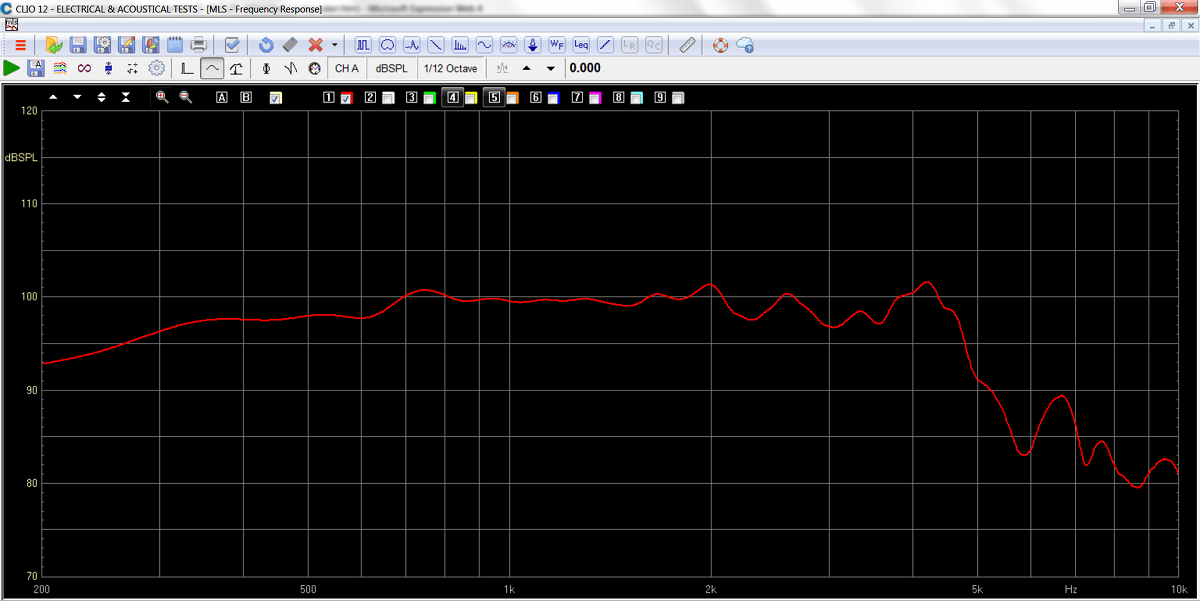
Let's start with the 10NDA610 midrange driver. Here on a 30 x 50 cm
baffle, not the final baffle. As can be seen this driver is useful for
some 98 dB sensitivity system with a point of crossover around 200 Hz.
Fairly flat frequency response that shouldn't cause much trouble in
crossover design.
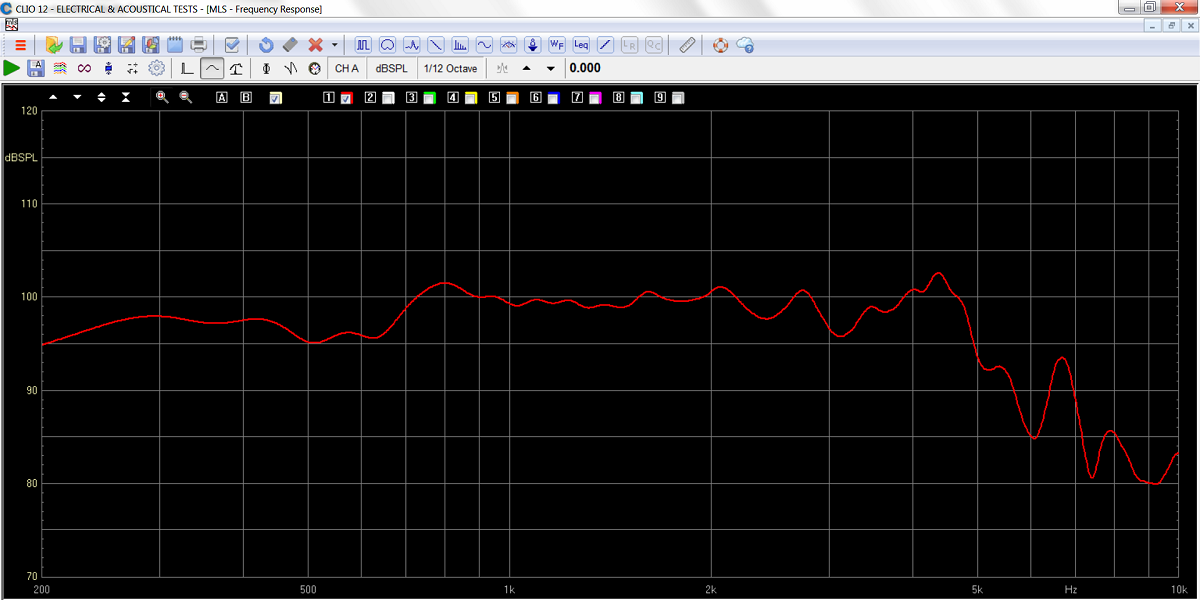
Above the 10NDA610 on the actual baffle, 65 x 105 cm. Not so nice! You
can never tell what happens when we change the baffle or the placement
of the driver.
The rise in SPL above 700 Hz calls for some equalisation to make a
smooth midrange, but it can be done with a notch filter.
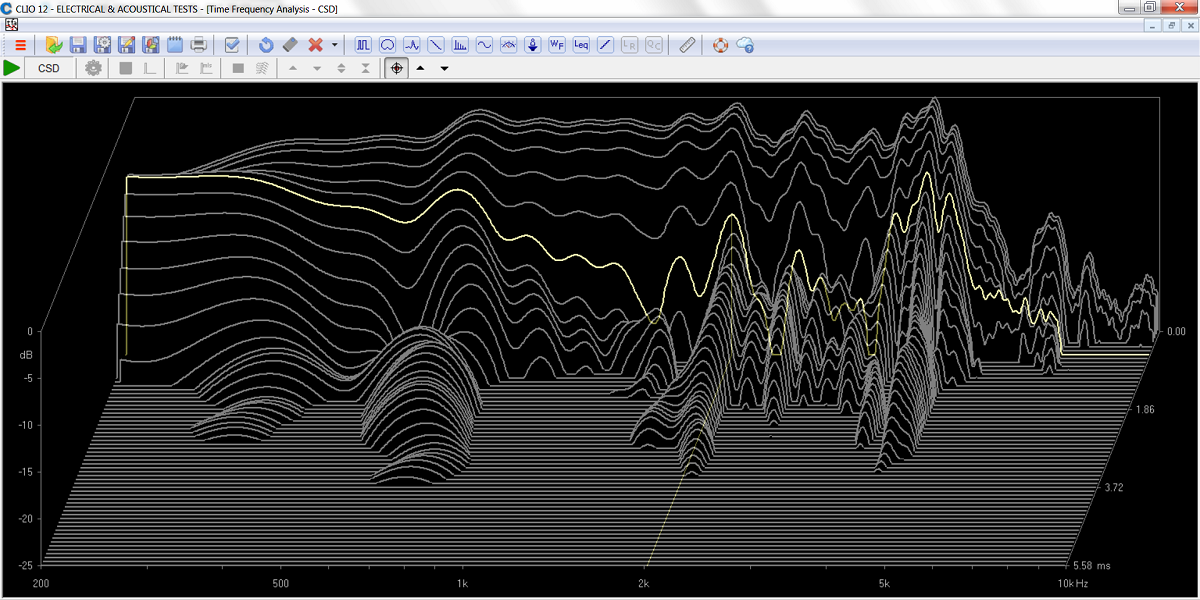
10NDA610 CSD. Looks like a very well behaved driver.
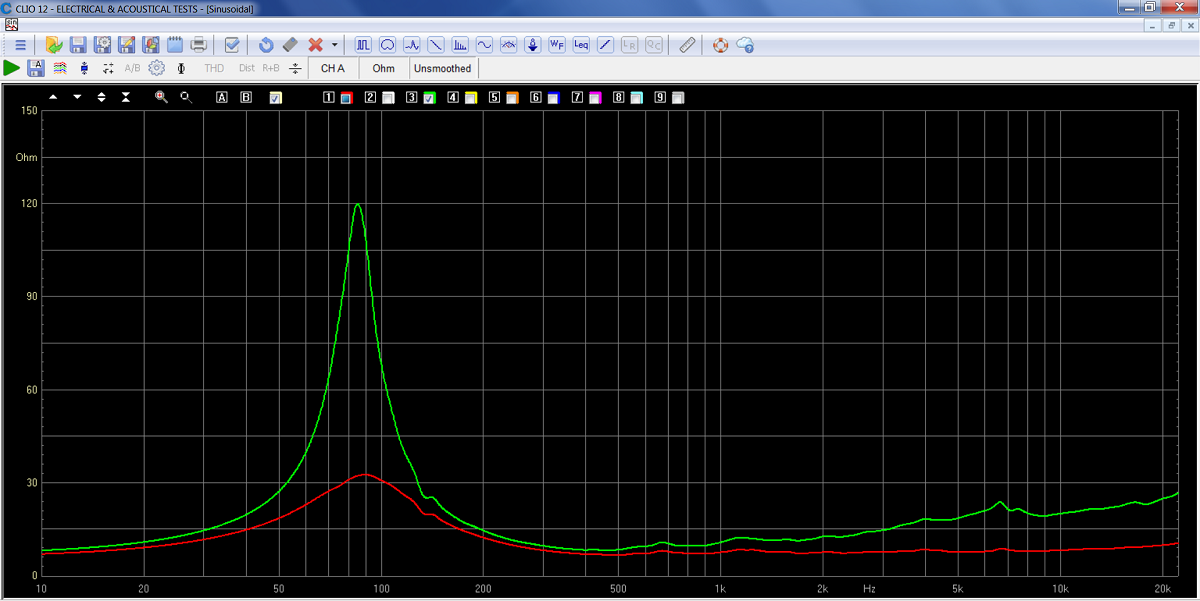
The 10NDA610 features a fixed coil on the pole piece (AIC, active
impedance control, read data sheet), picking up eddy current, and if we
connect this coil in parallel to the voice coil we see the above. Green
is without AIC and red is with AIC, making a nice flat impedance.
Whether this will be useful in crossover design is to be seen. Sometimes
the rise in impedance can be a useful tool in reaching target roll-off
profile.
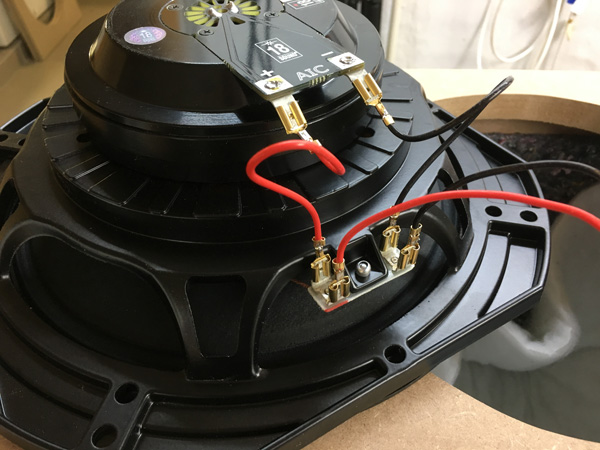
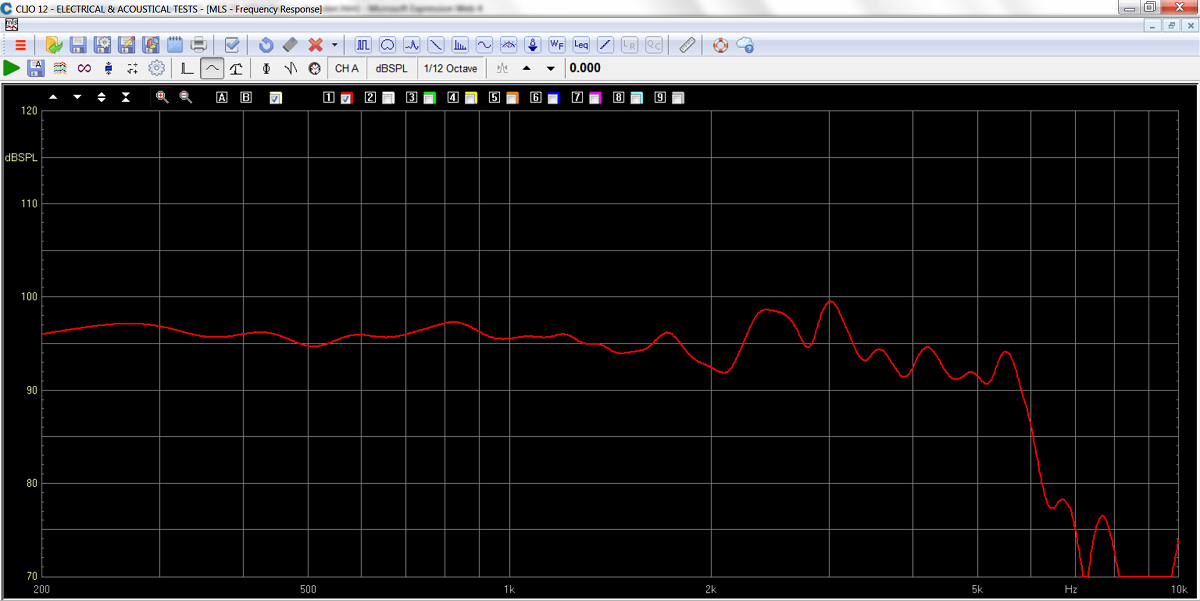
Above the 10" 10NW650 mid-bass driver from 18 Sound. Here on
the same 65 x 105 cm baffle.
Nice! However, whether this is suitable for midrange is to be seen - and
heard. In terms of crossover, much easier.
These 18 Sound guys make some nice drivers!
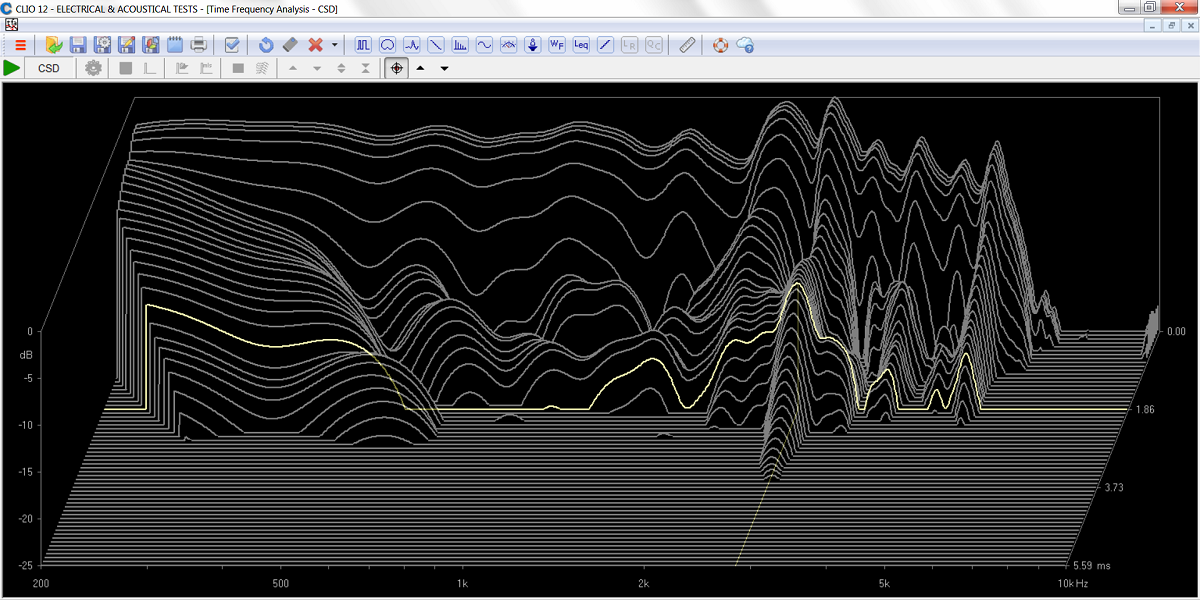
10NW650 CSD.
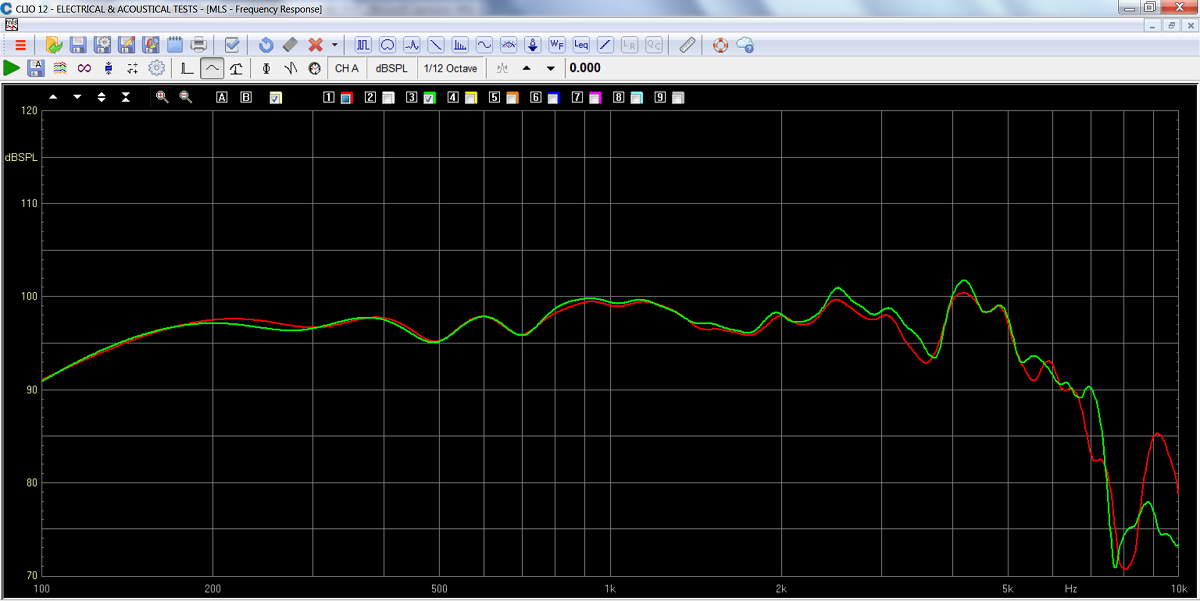
The two JBL 2123H drivers on actual baffle. Not bad at all!
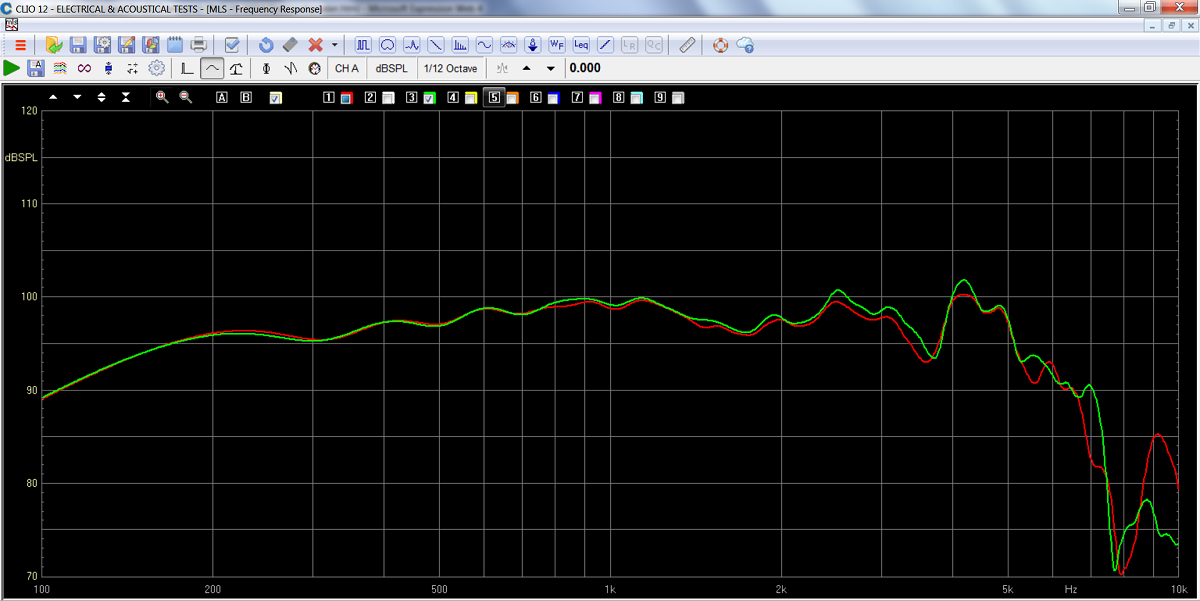
The two 2123H drivers on a 30 x 50 cm baffle, placed in middle. Even
smoother response.
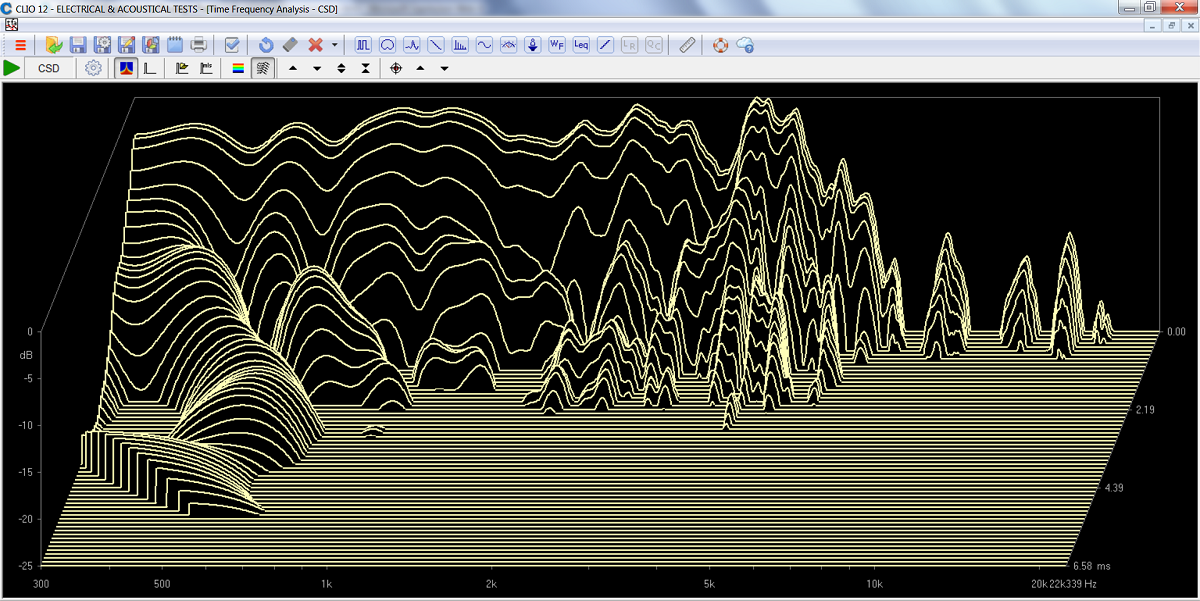
Above the waterfall plot of one of the 2123H drivers.
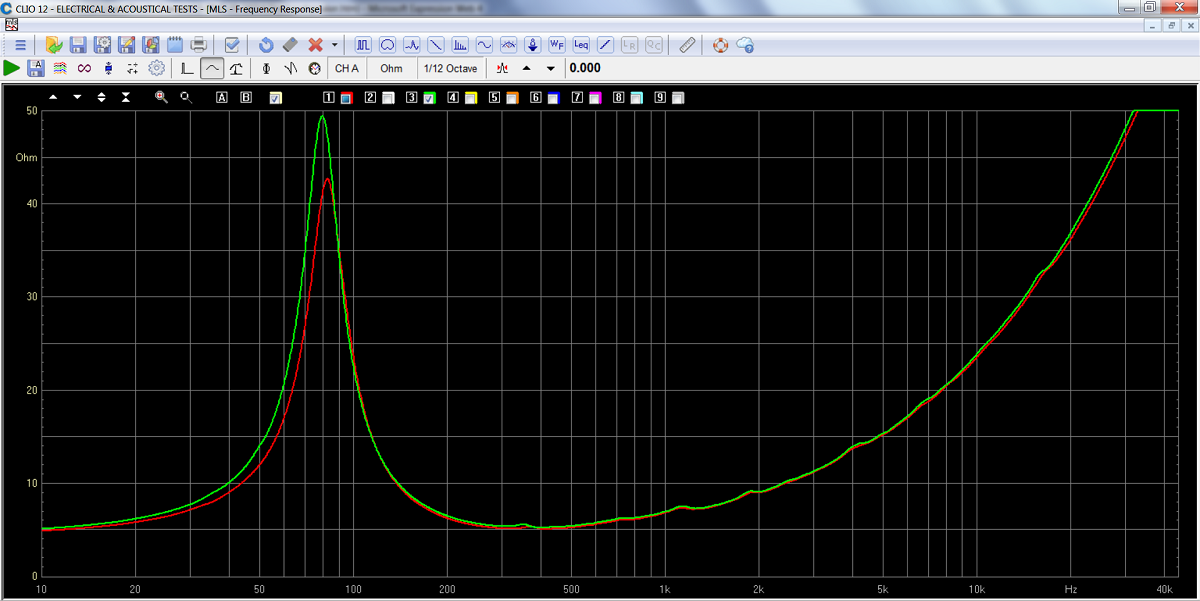
Above impedance measurements of the two drivers. Very similar
performance.
Drivers DC resistance were 4.49 and 4.35 Ohm, respectively.
All in all the performance of these 2123H drivers look really good and appear worthy of future applications.
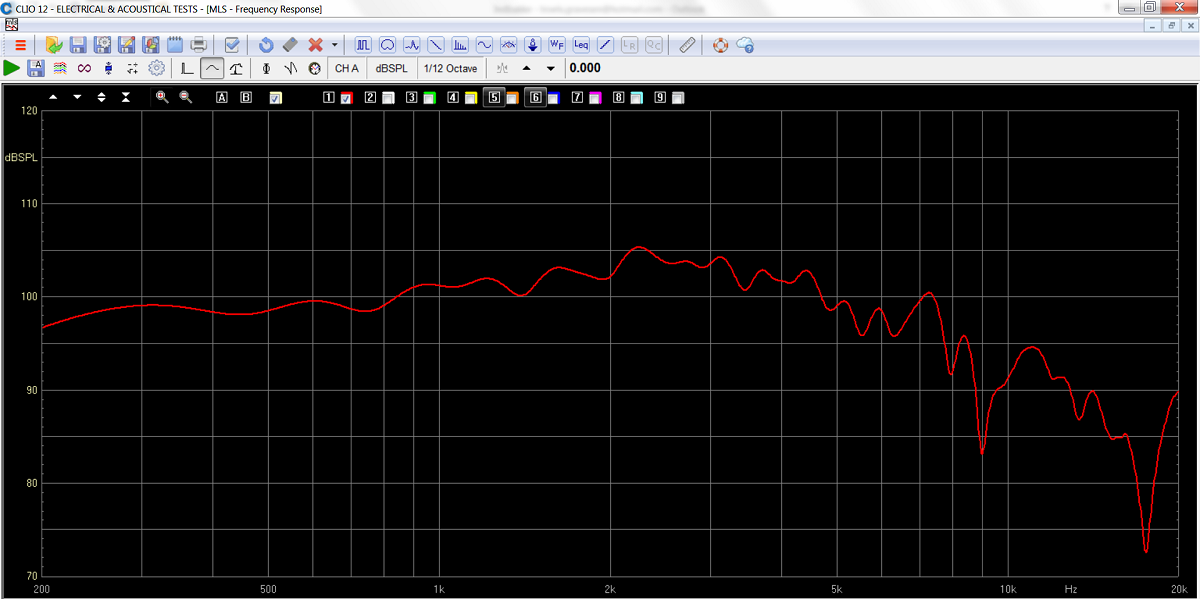
Frequency response of 10NMBA520 driver on 65 x 105 cm baffle.
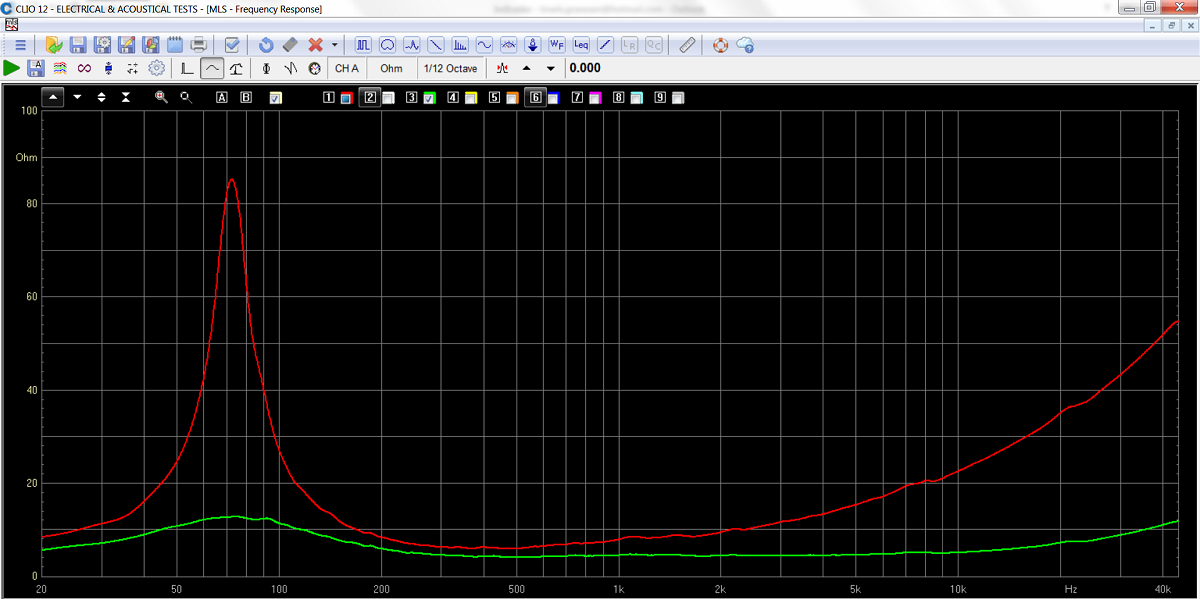
10NMBA520 impedance w/wo AIC (active impedance control)
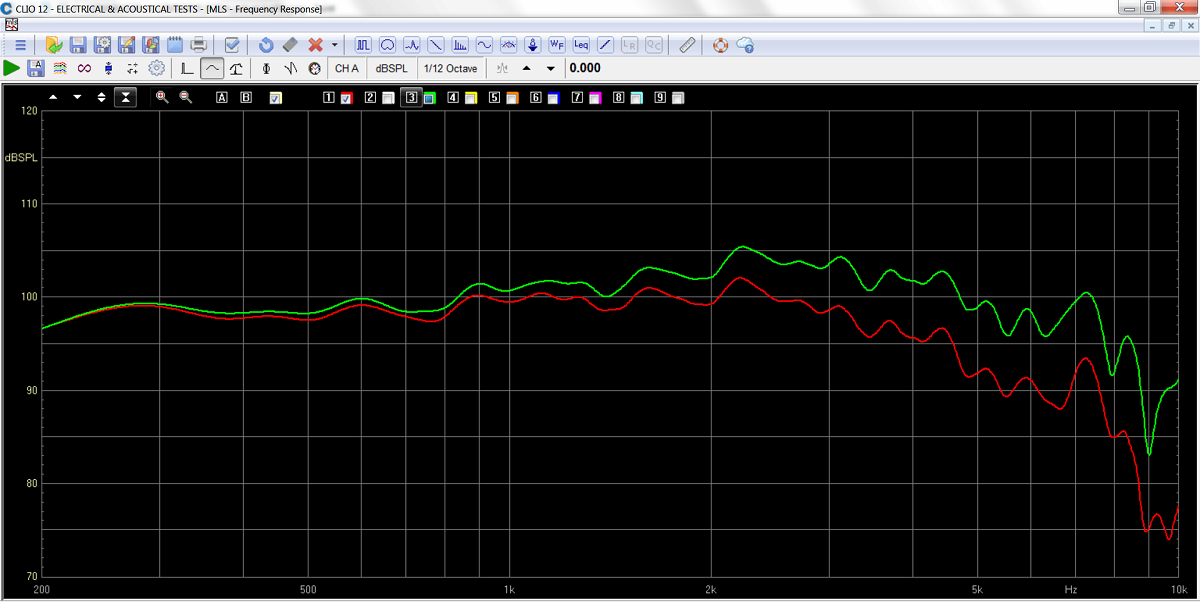
10NMBA520 frequency response w/wo AIC. Red = without.
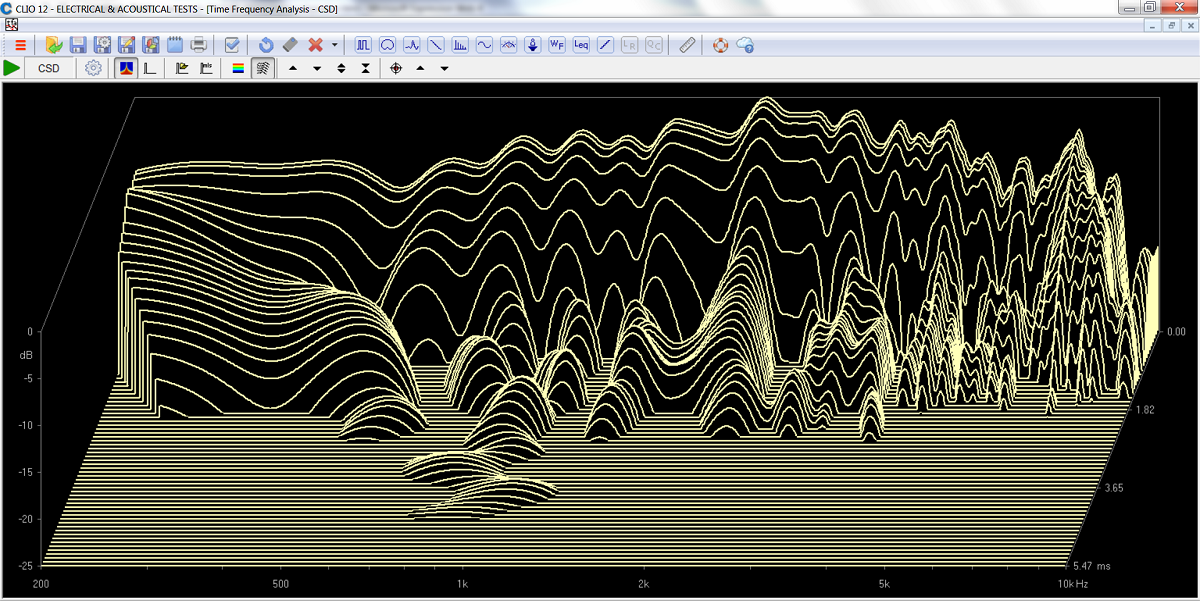
CSD, 10NMBA520.
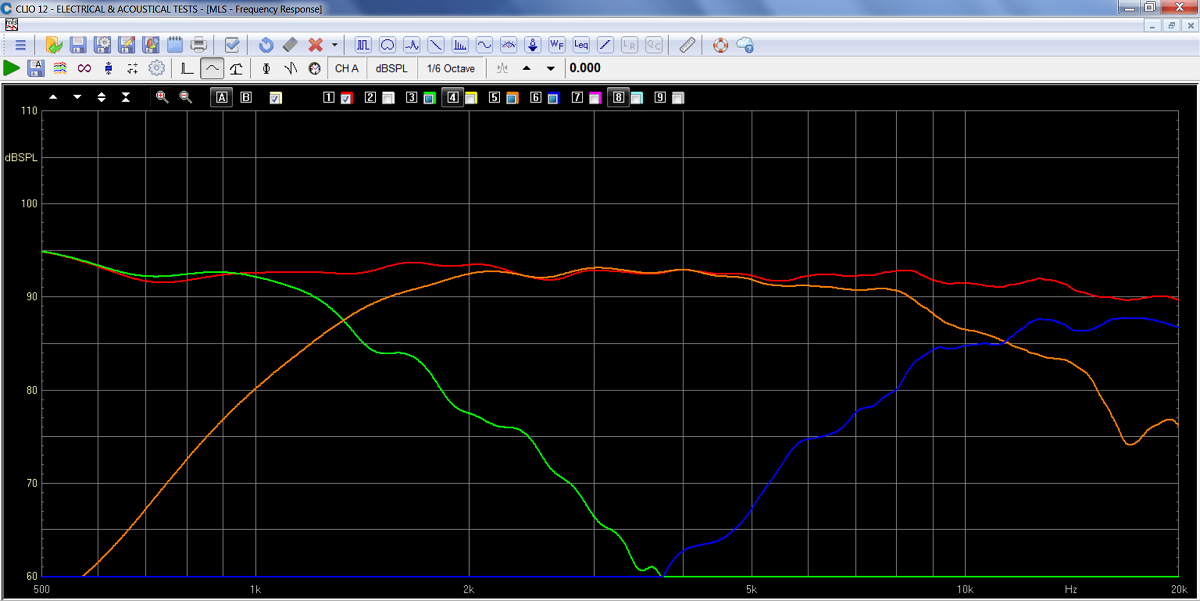
So, here's the response from the final crossover showing midrange
(green) from 500 Hz, the horn (orange) and tweeter.
It is of paramount importance the treble range being smooth as seen
above.
I don't have the facilities to measure how deep they go, but believe me,
they go deep.
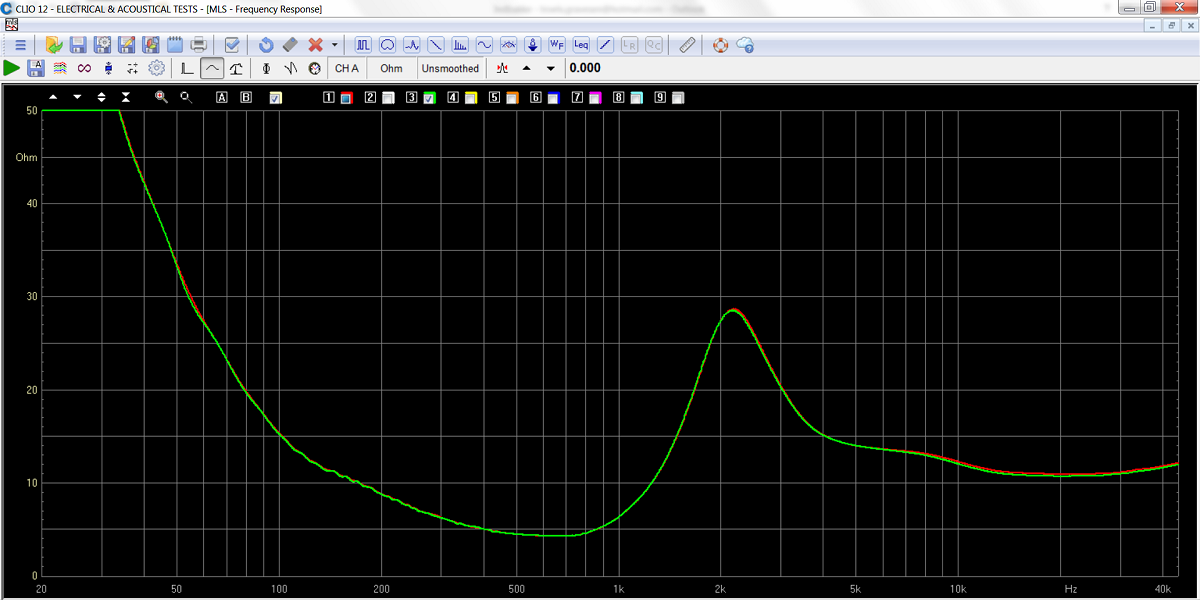
Above the midrange-tweeter section impedance of the two speakers, red
and green.
Minimum impedance is 4.3 Ohms.
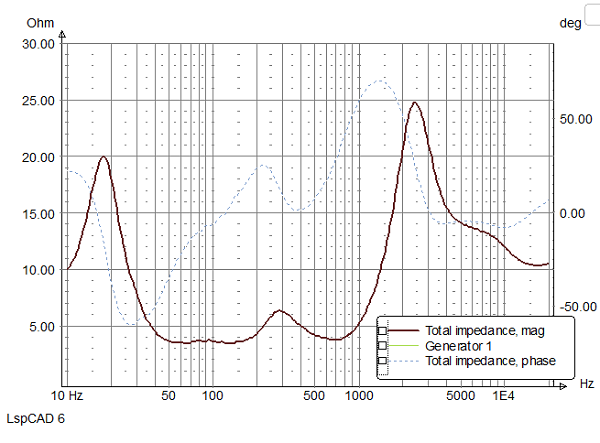
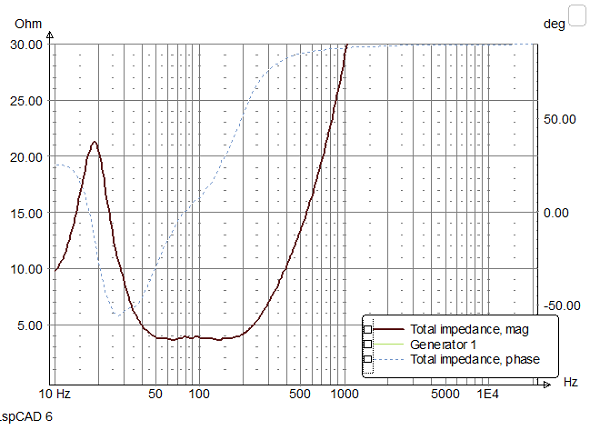
Left: Final fully passive system impedance based on simulation. Minimum
3.8 Ohms @ 70 Hz.
Right: Bass alone from crossover.
Download Complete Kit
Sale Presentations:
Six versions:
TL-1, fully passive level 1
TL-1, fully passive level 2
TL-1, semi-active, level 1, no Hypex included
TL-1, semi-active, level 1, with Hypex included
TL-1, semi-active, level 2, no Hypex included
TL-1, semi-active, level 2, with Hypex included
2023: Having been around for some time
now, it has been decided to launch the TL-1 and TL-2 in two versions,
where:
Version 1 comes with Superior-Z for midrange, Amber-Z for horn and
Alumen-Z caps for super-tweeter.
Version 2 comes with Superior-Z for midrange and Alumen-Z for both horn
and super-tweeter.
Should you want Alumen-Z for also the midrange and Amber-Z for both horn
and super-tweeter, you have to make special request.
All kit and component prices may be subject to change and are always to be confirmed by Jantzen Audio Denmark.
BMS and 18 Sound components can be bought from
LEAN, UK
Super-tweeter:
Visaton: e.g.
hifisound, Germany
LEAN 2023 prices.
Download Complete Kit
Sale Presentations:
All technical questions to troels.gravesen@hotmail.com
All questions regarding purchase of kits, please mail Jantzen Audio at contact@jantzen-audio.com
CROSSOVER-LAYOUT
BACK TO INDEX
Please follow this link before making the crossovers:
http://www.troelsgravesen.dk/LCR-RC.htm
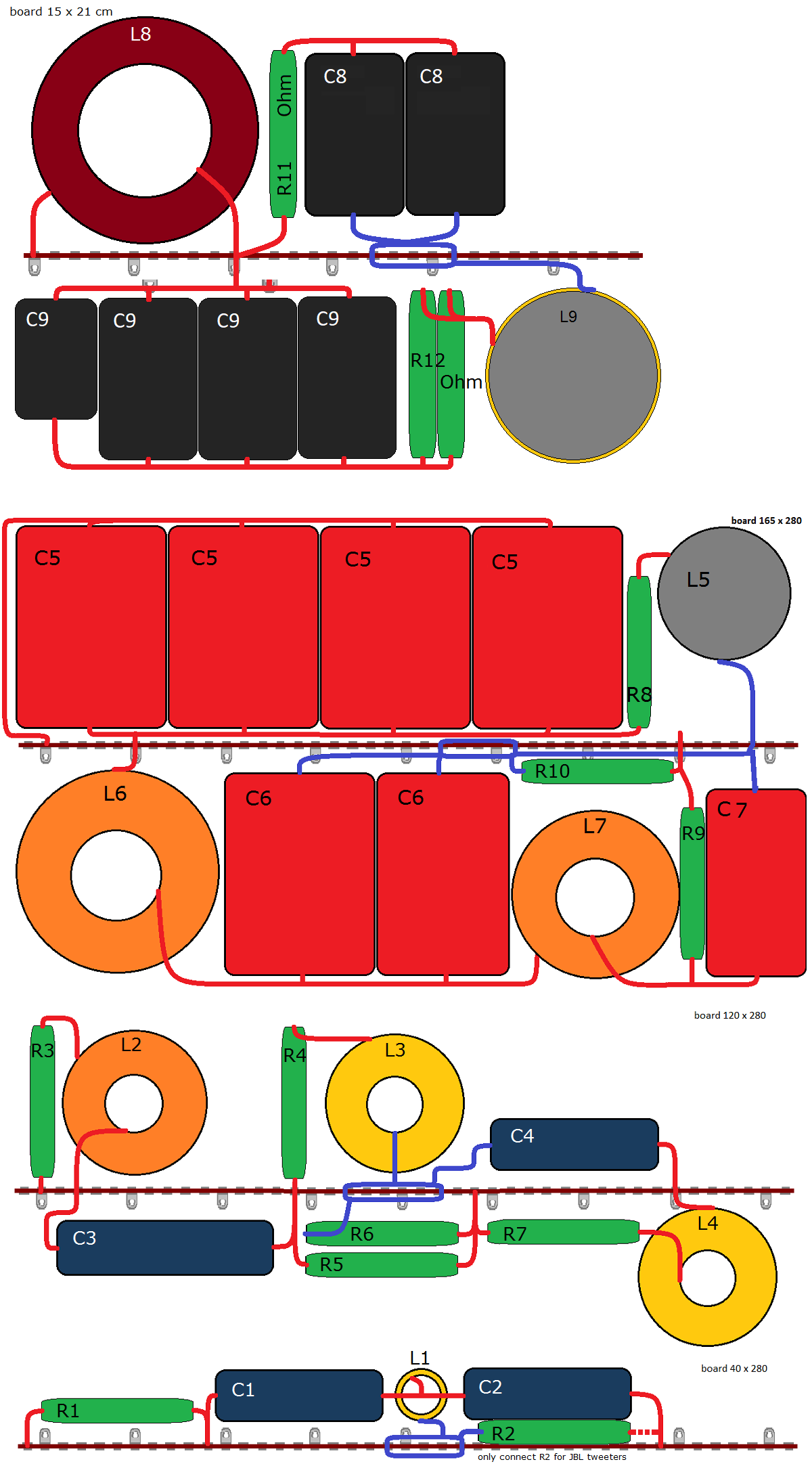
Click images below to view large
Here again the mounting of crossovers:
Speaker wiring
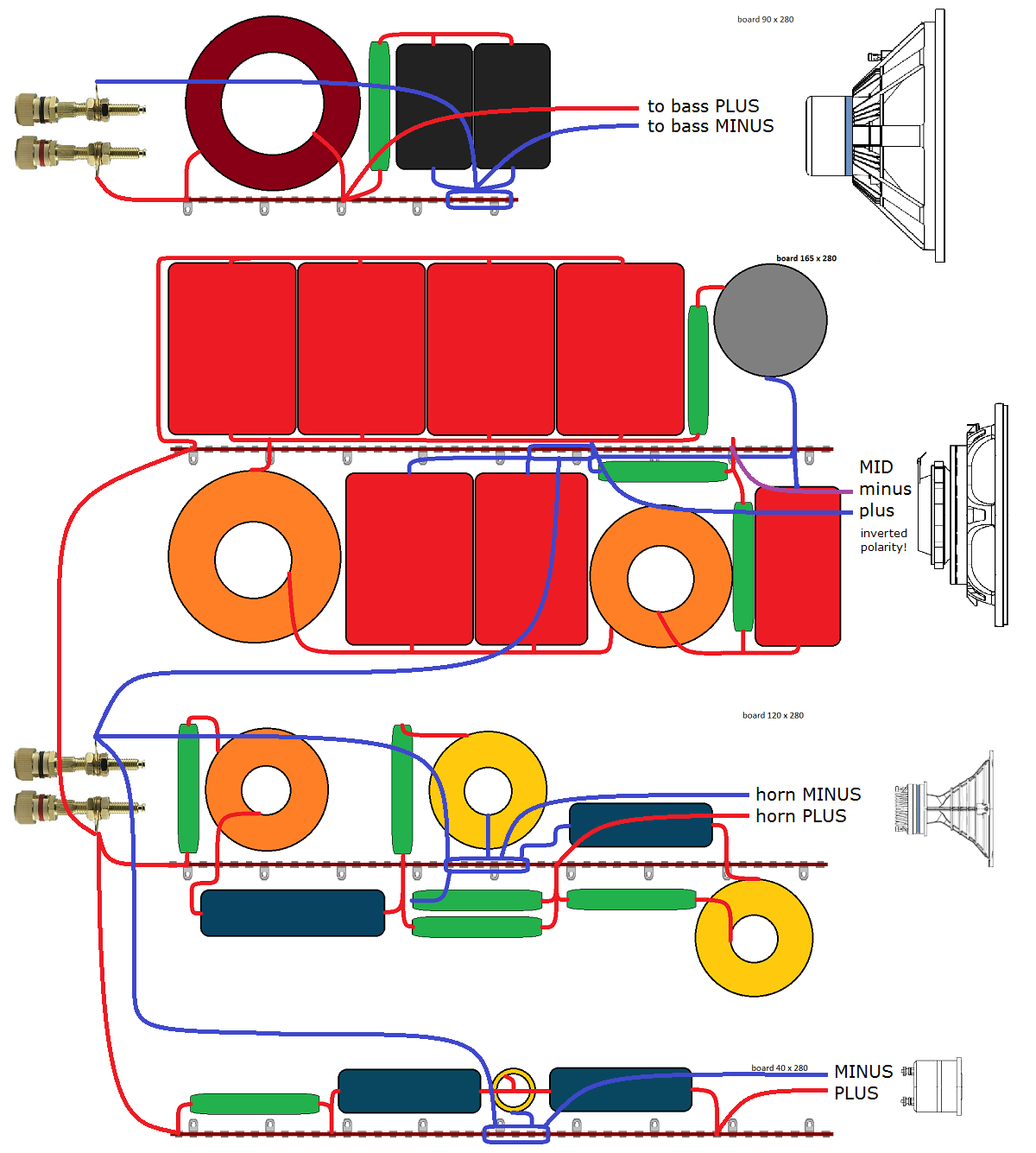
Above the fully passive version. Bi-amping recommended.
Wiring for the bass is the same with the bass LCR circuit (not shown
above).
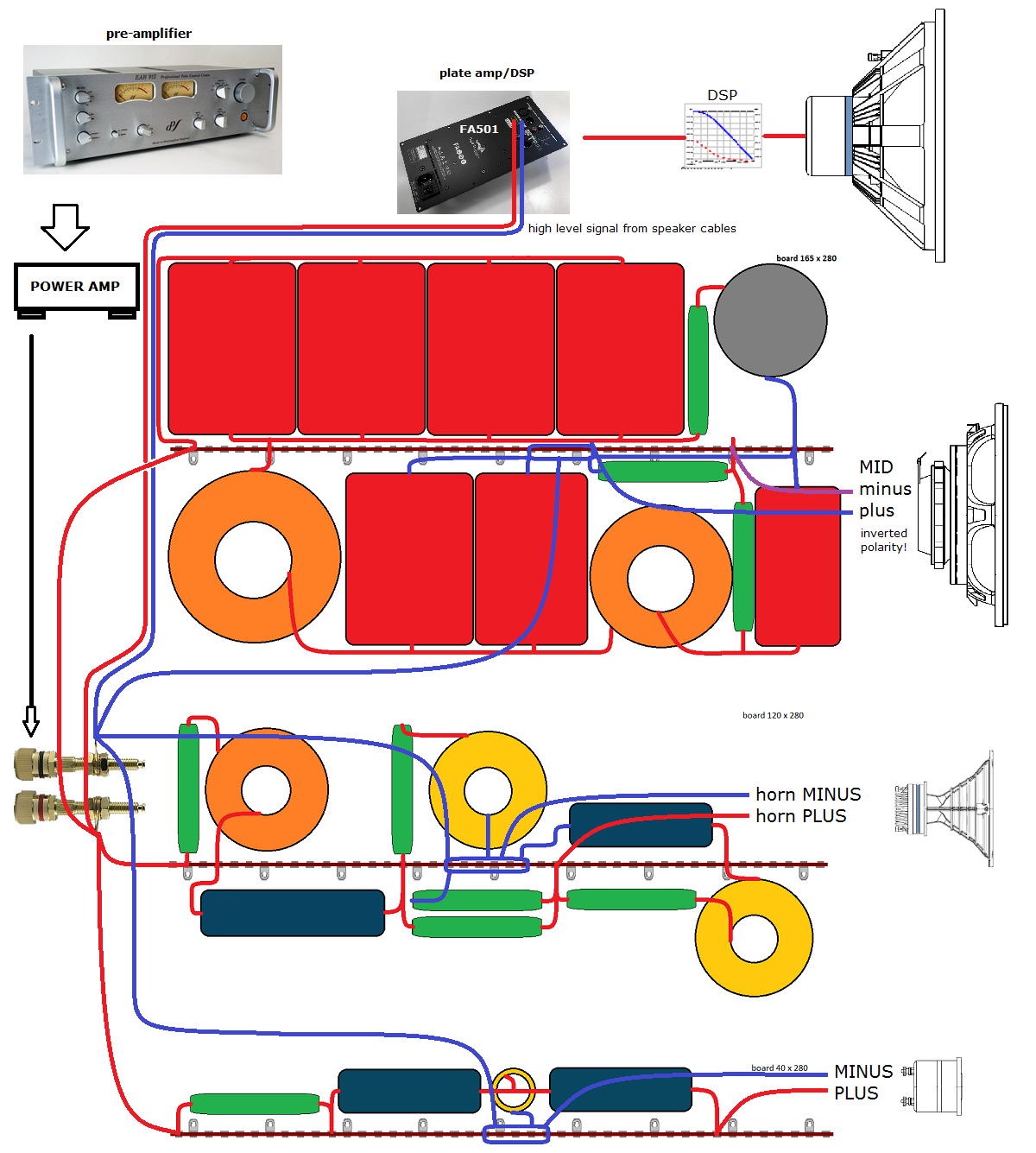
Above the semi-active version with the Hypex module.
